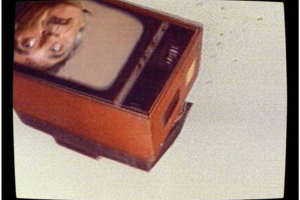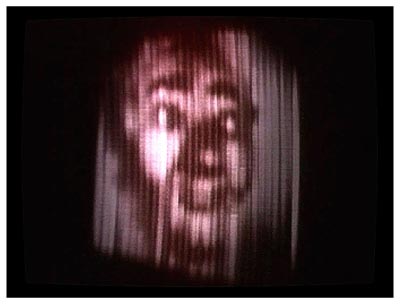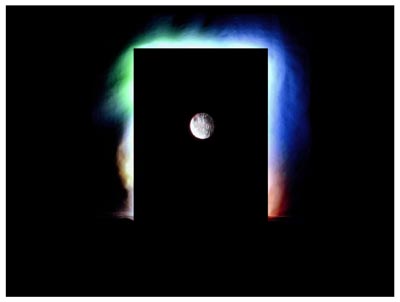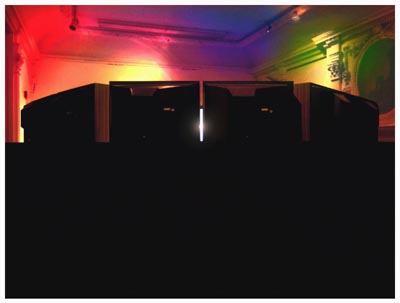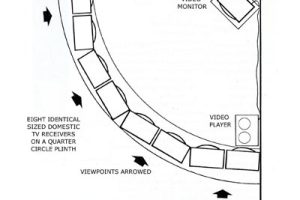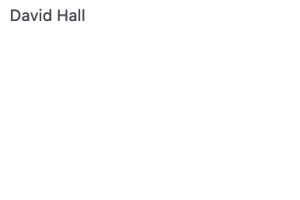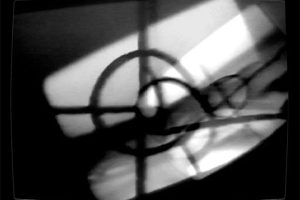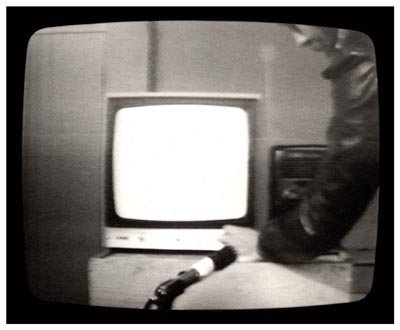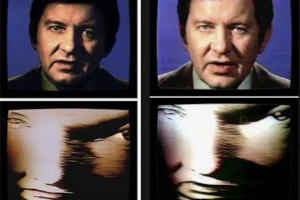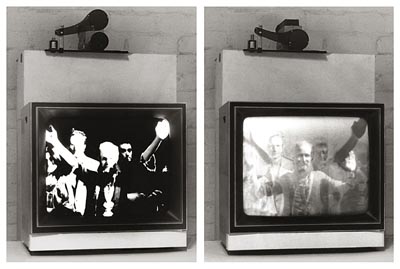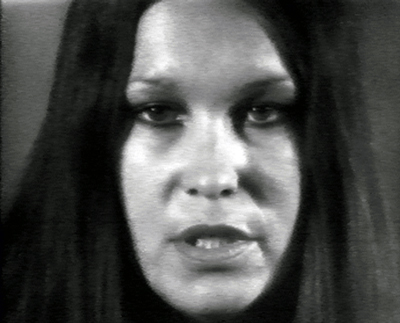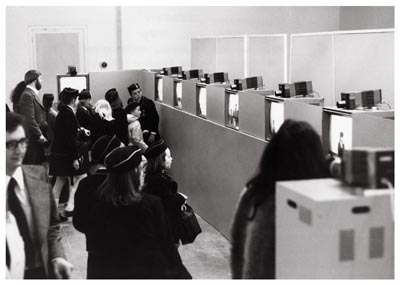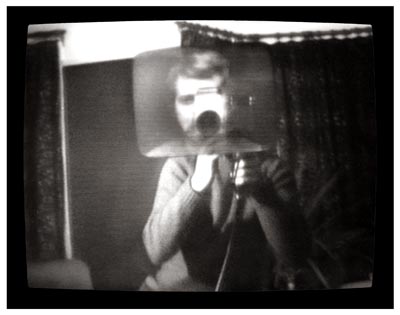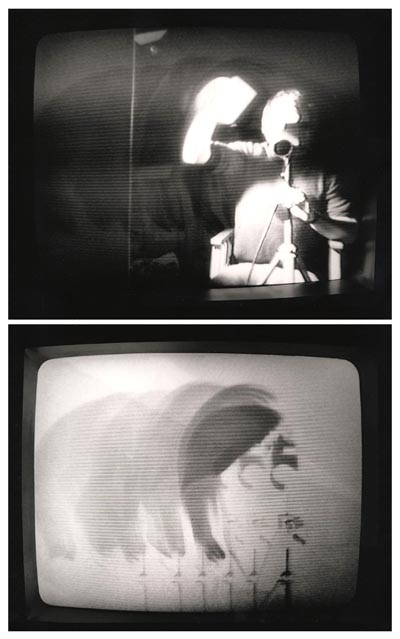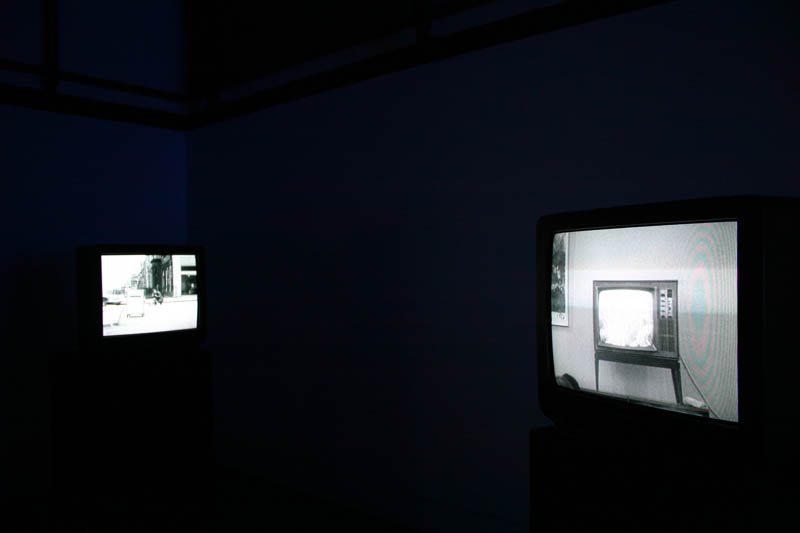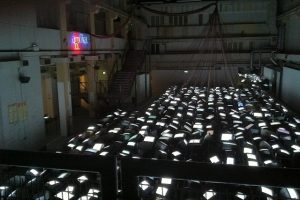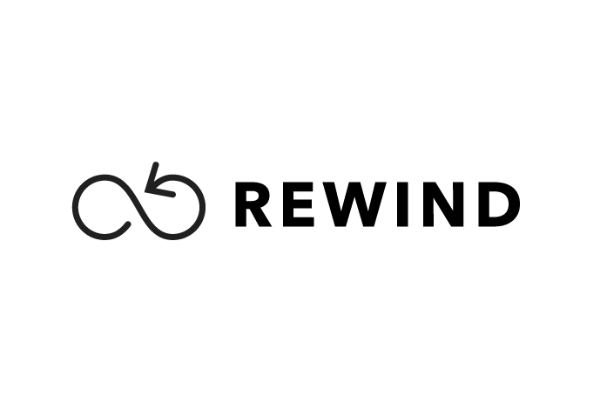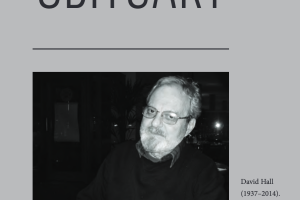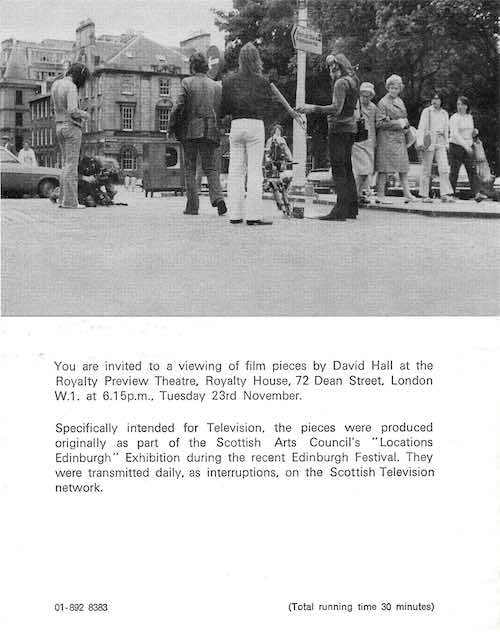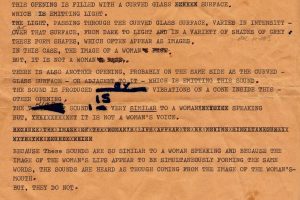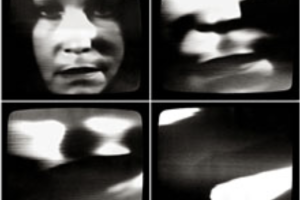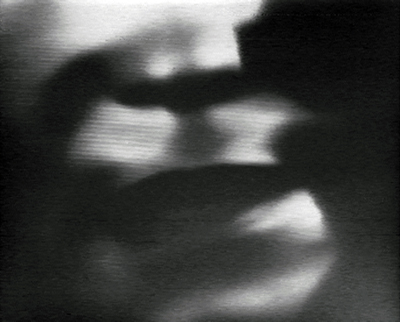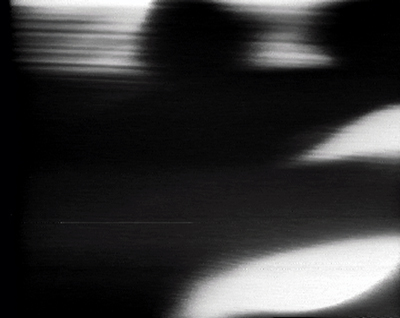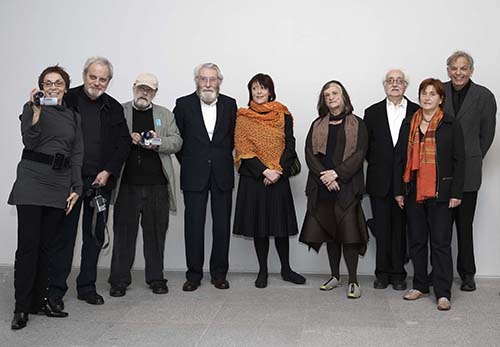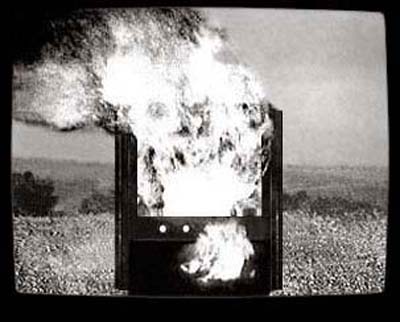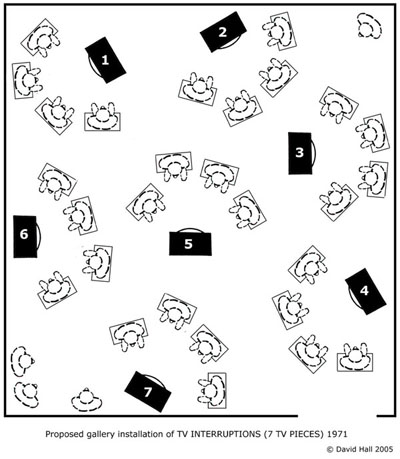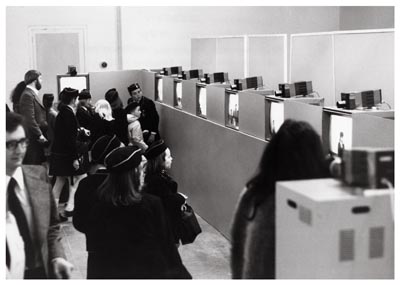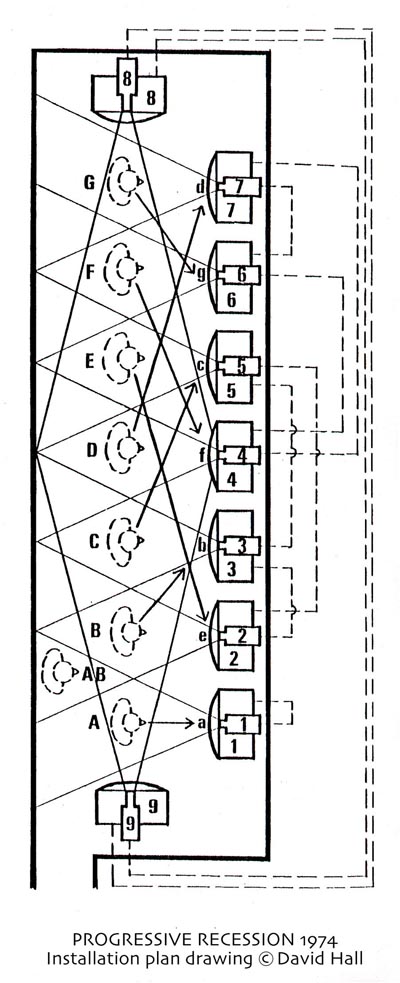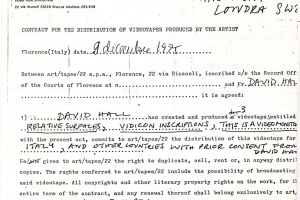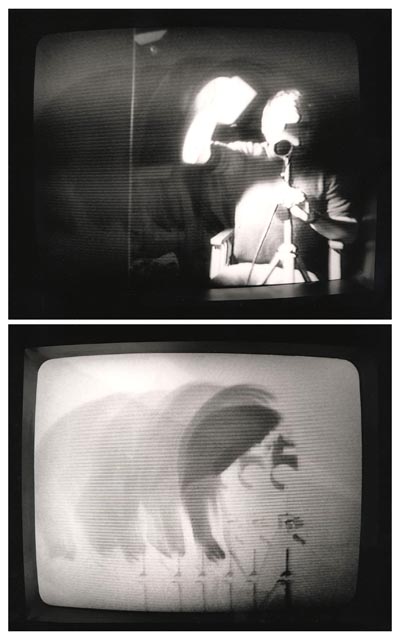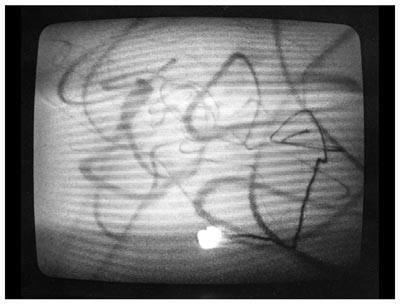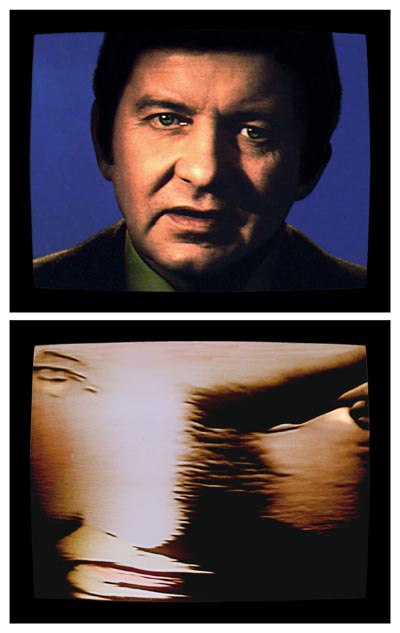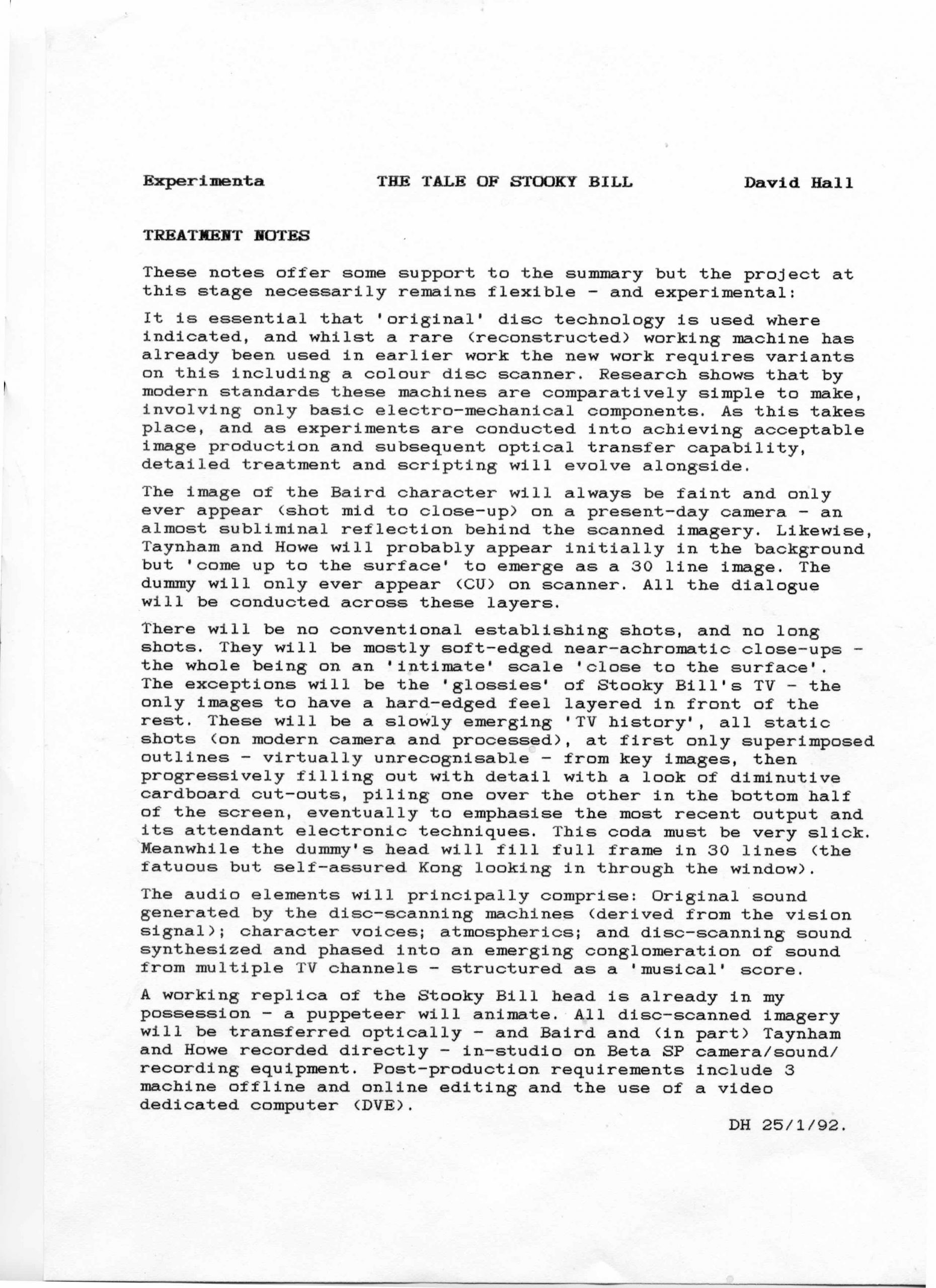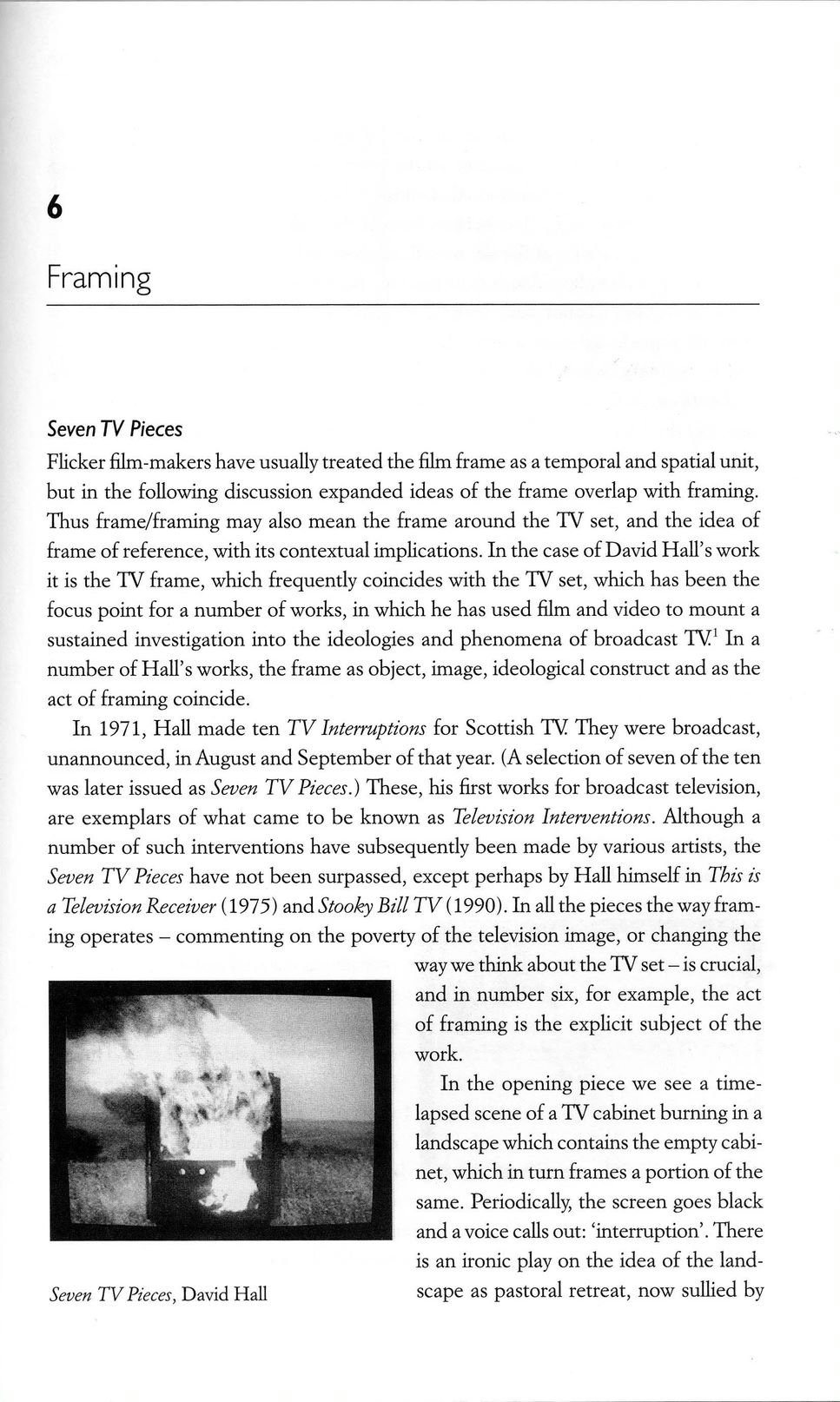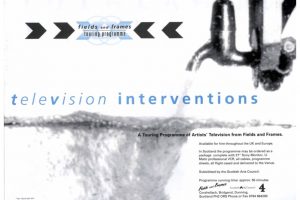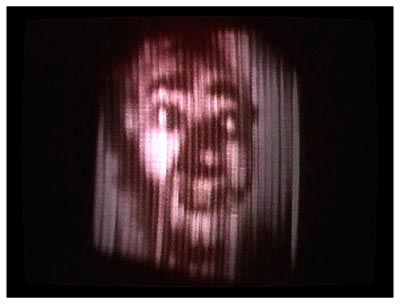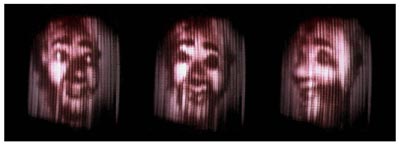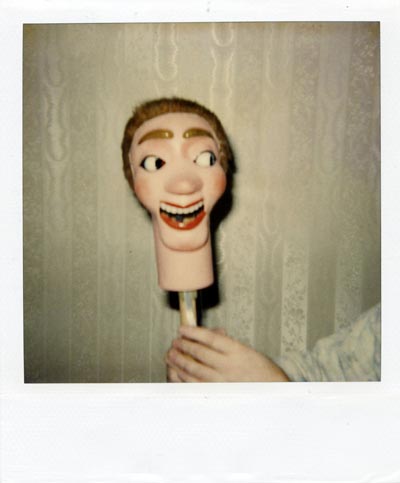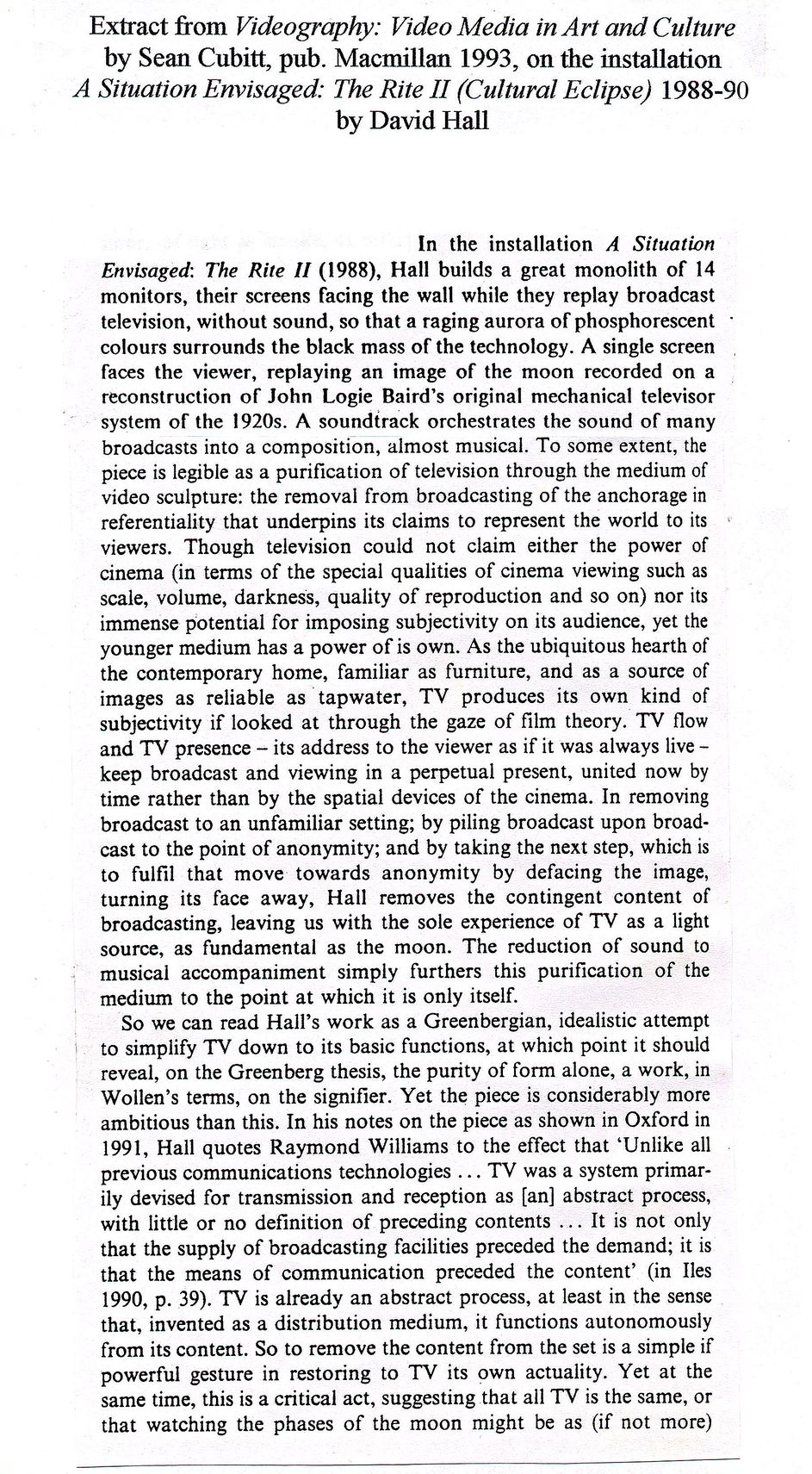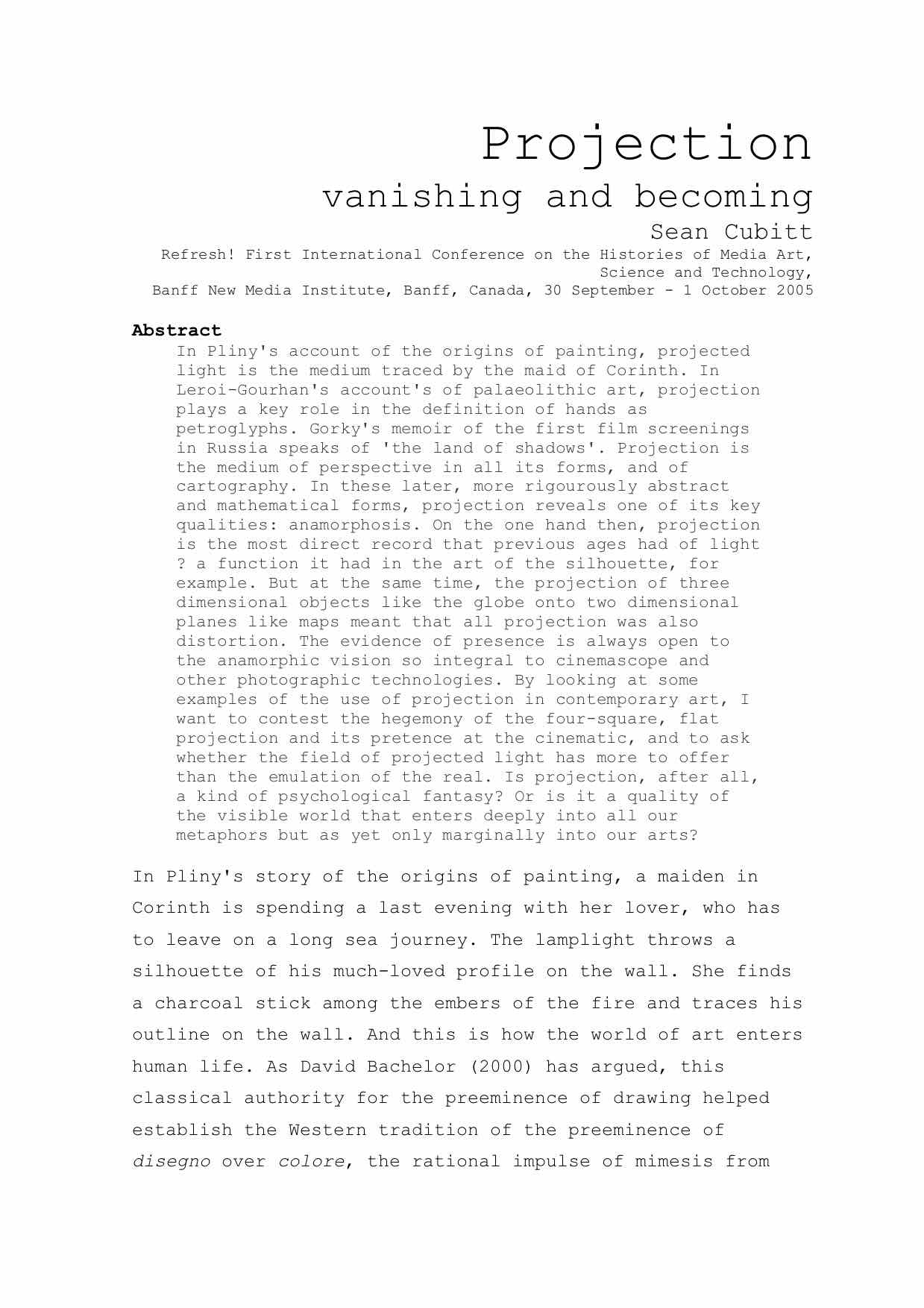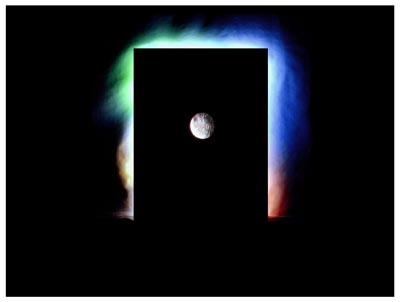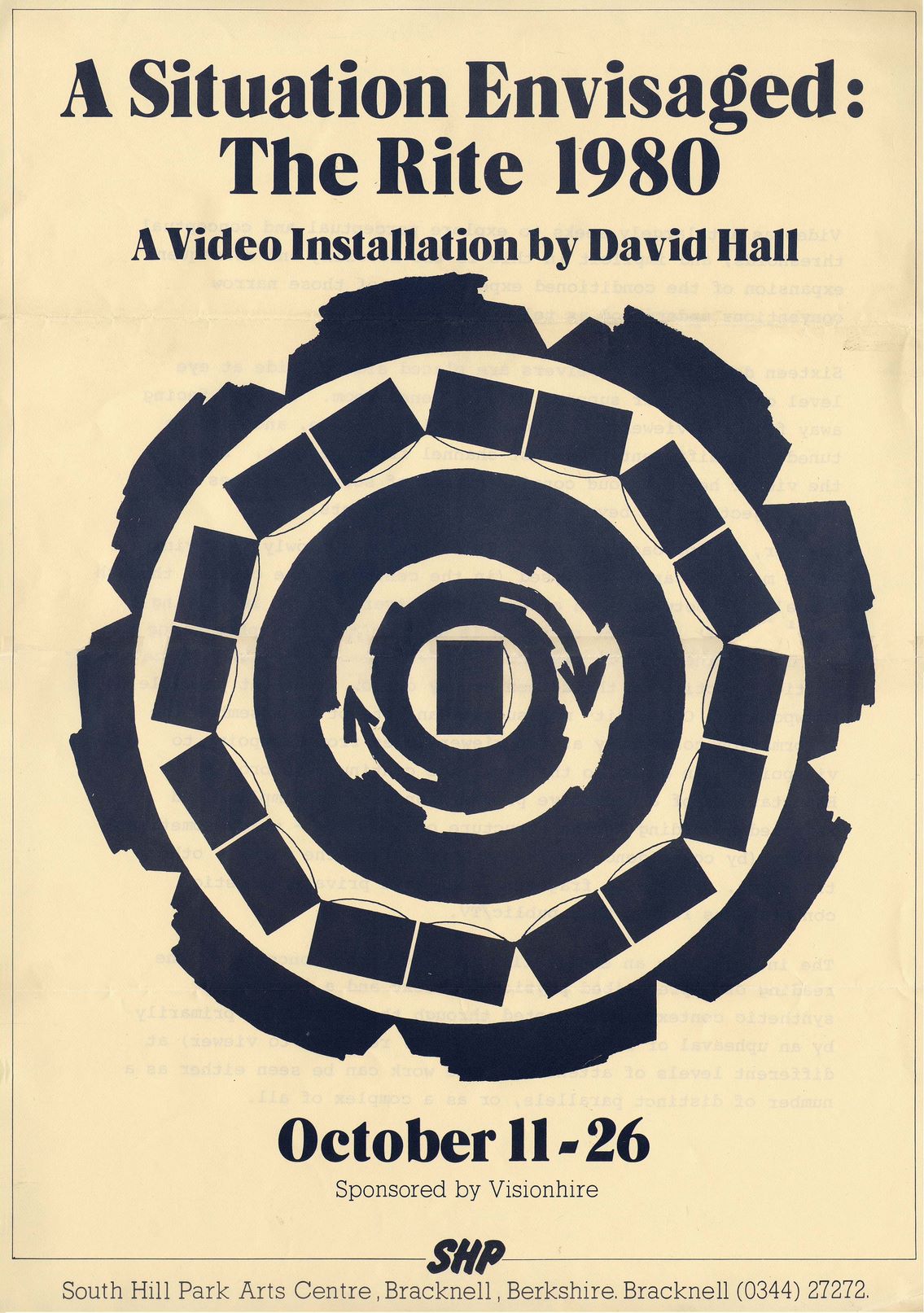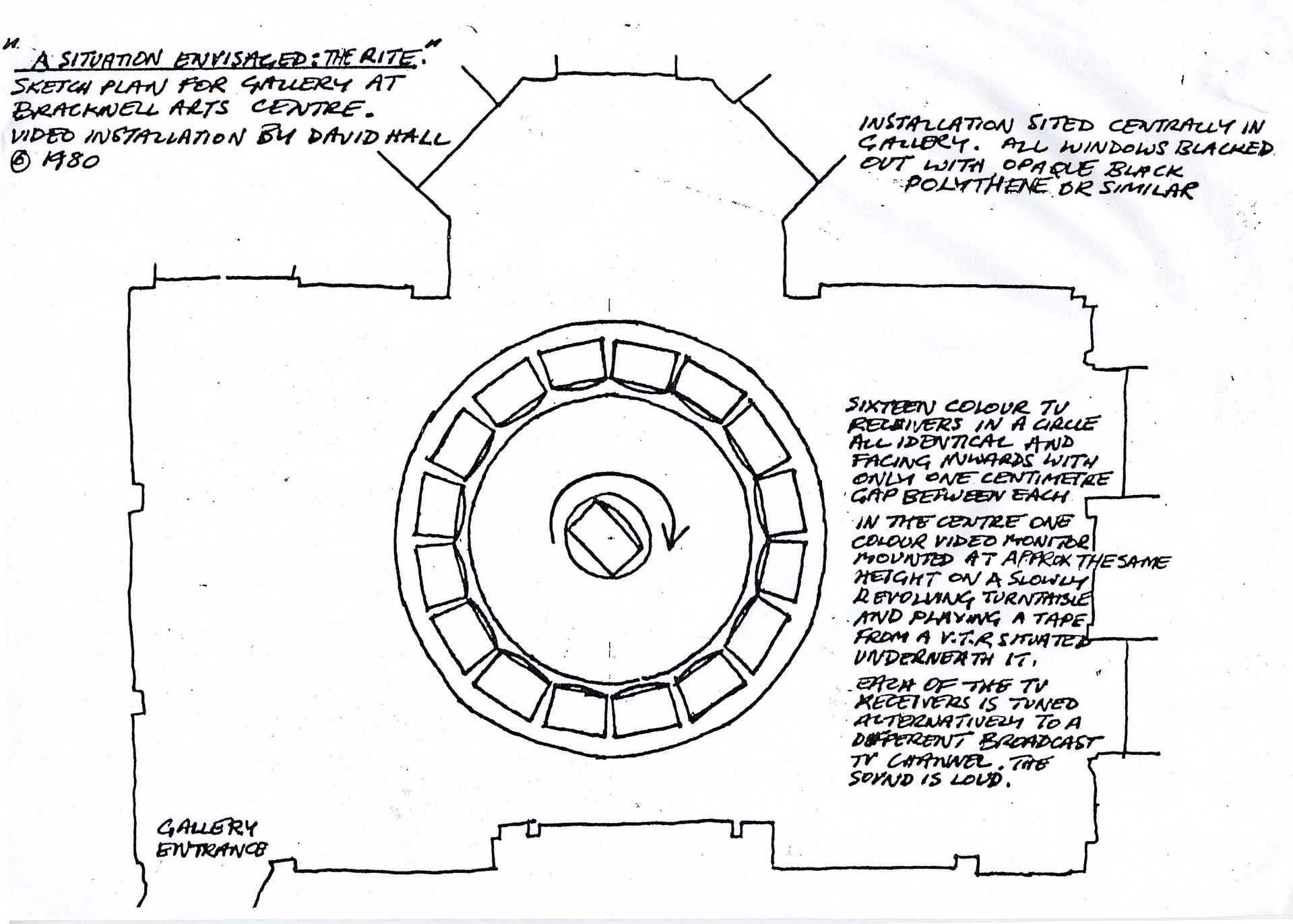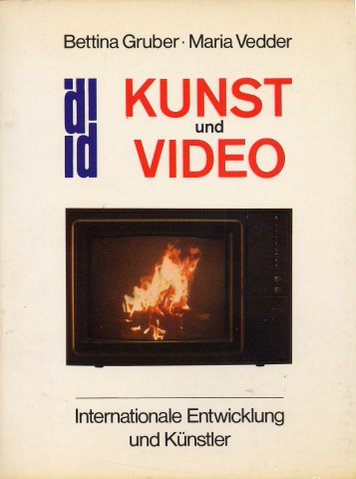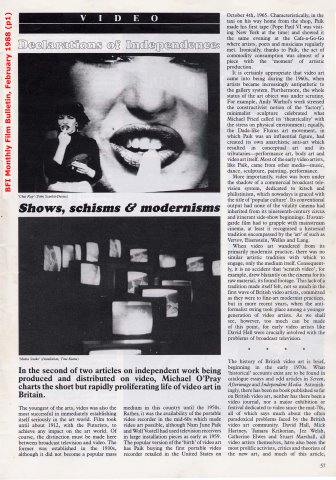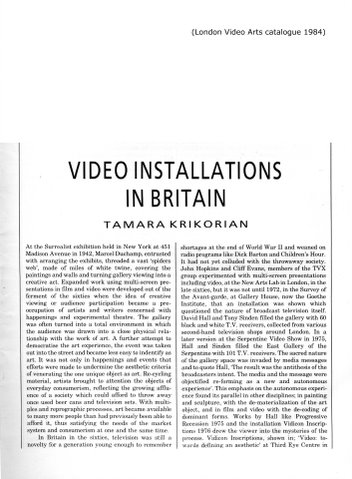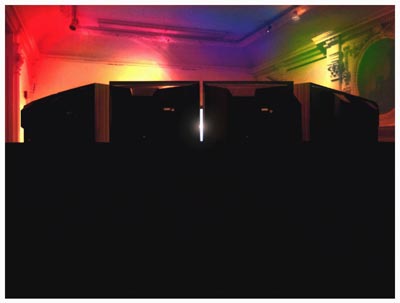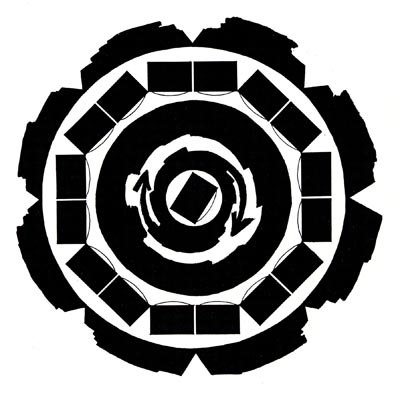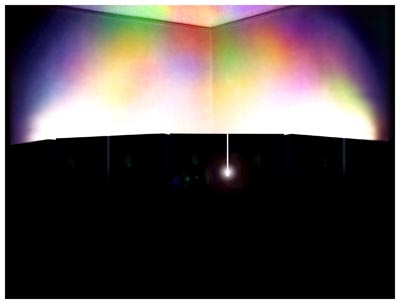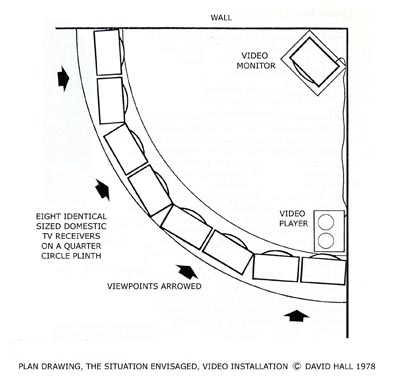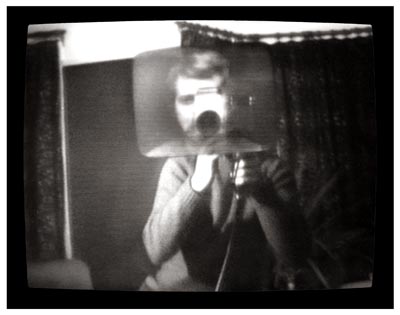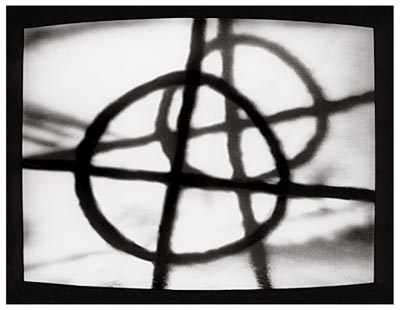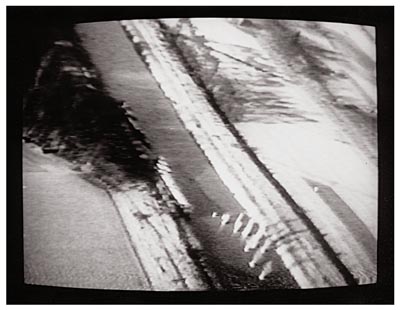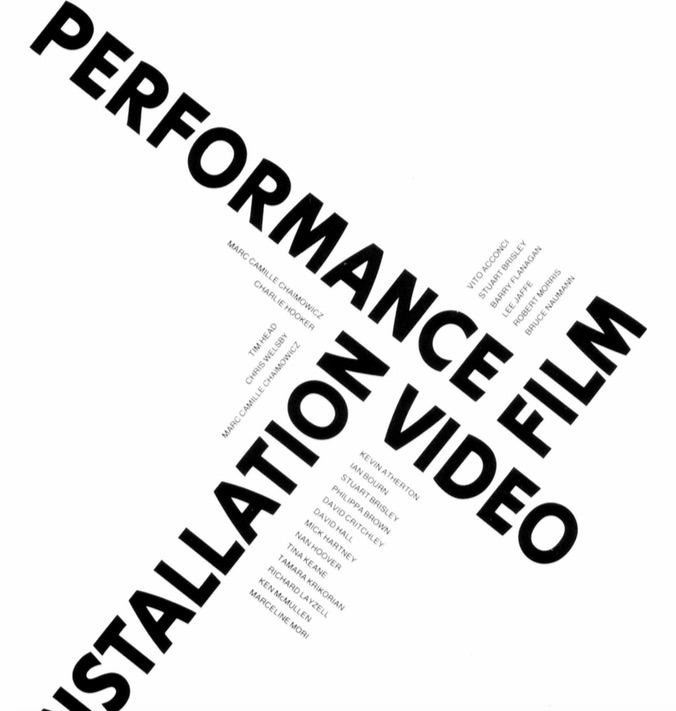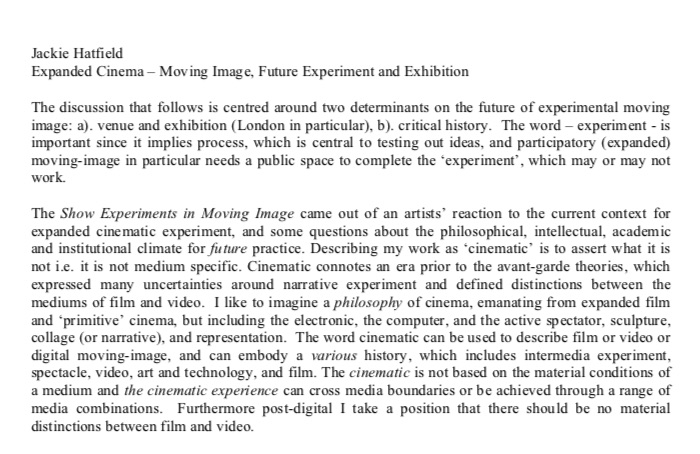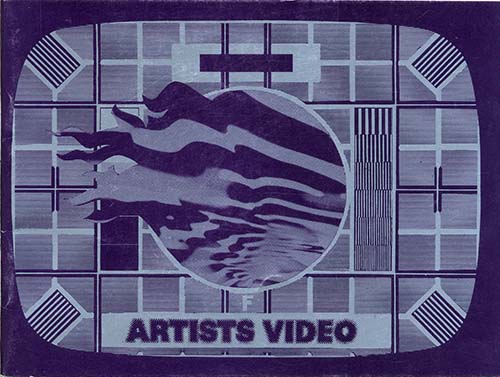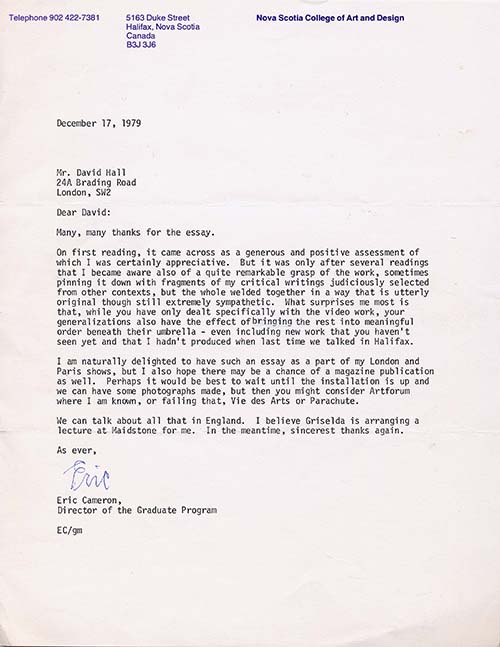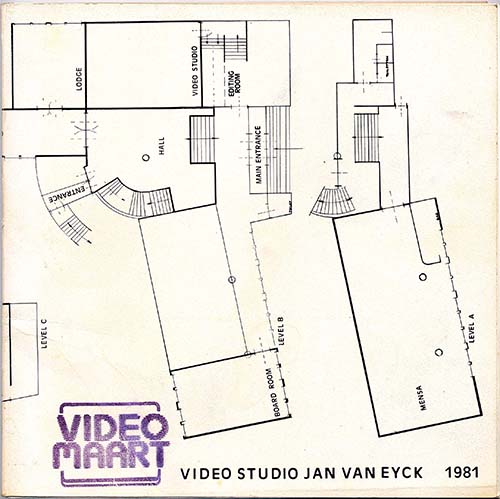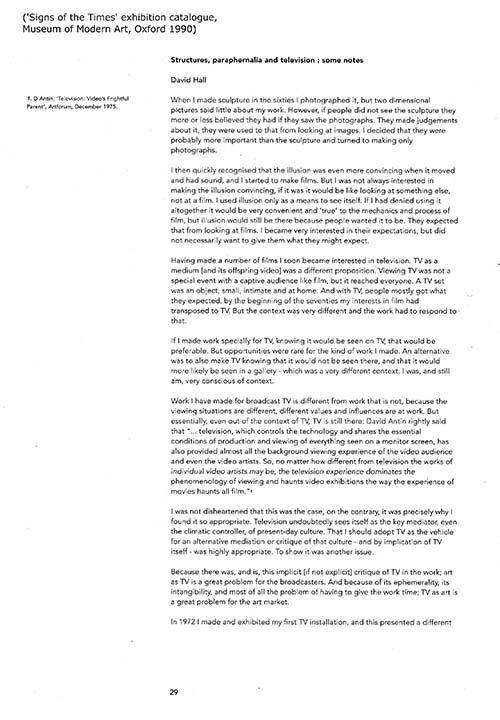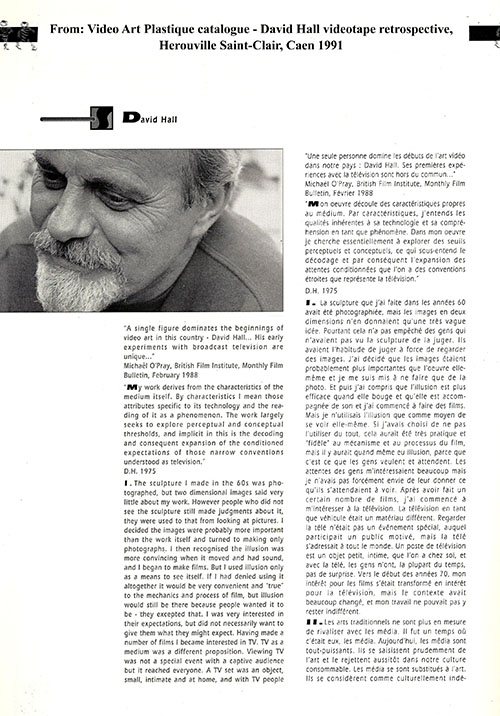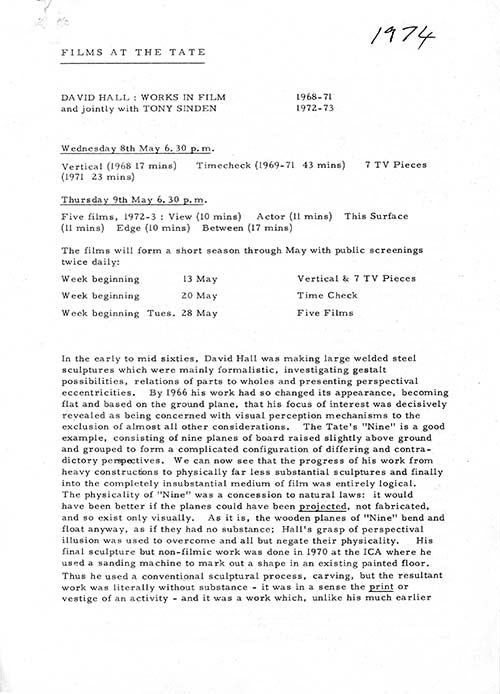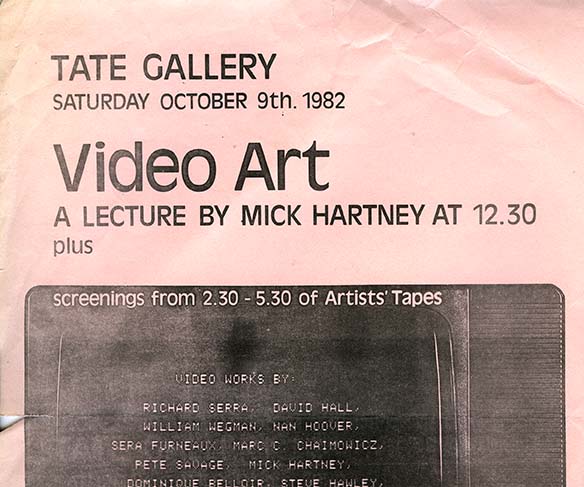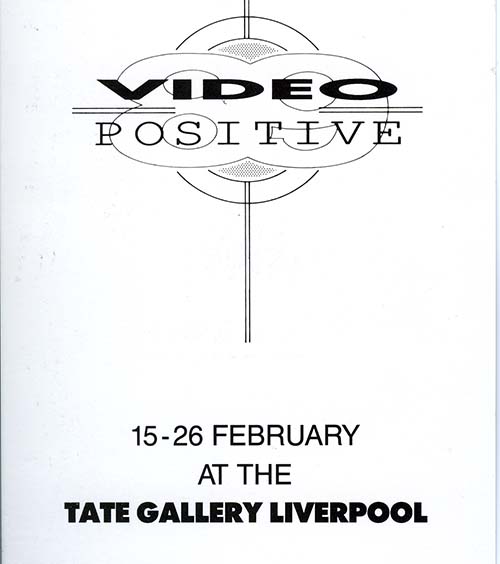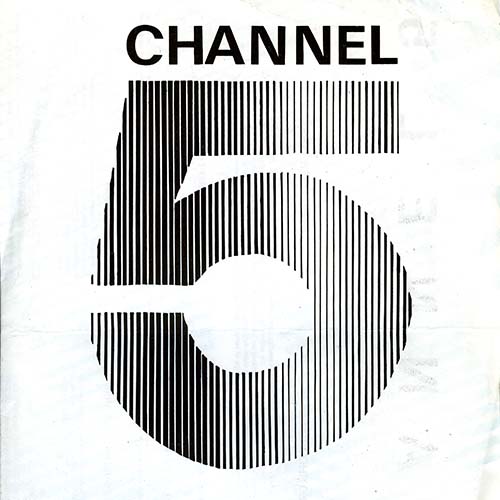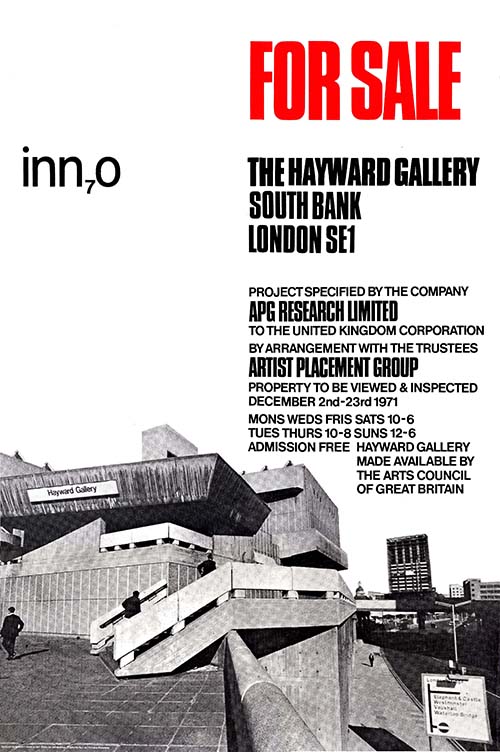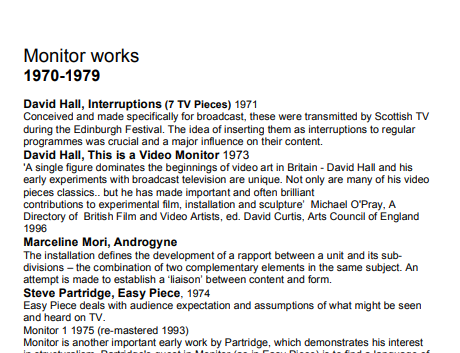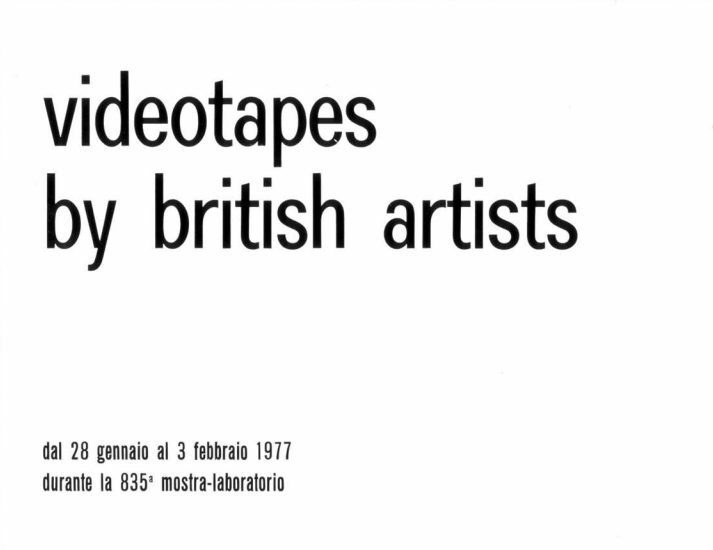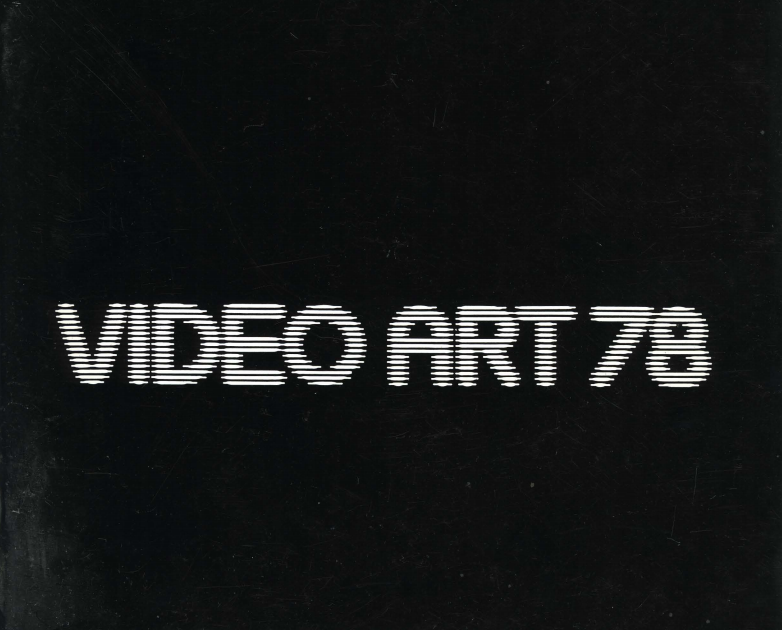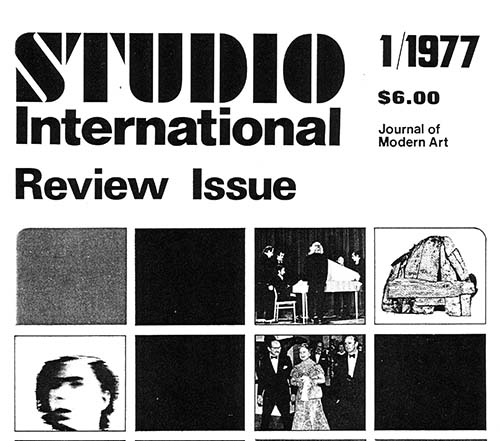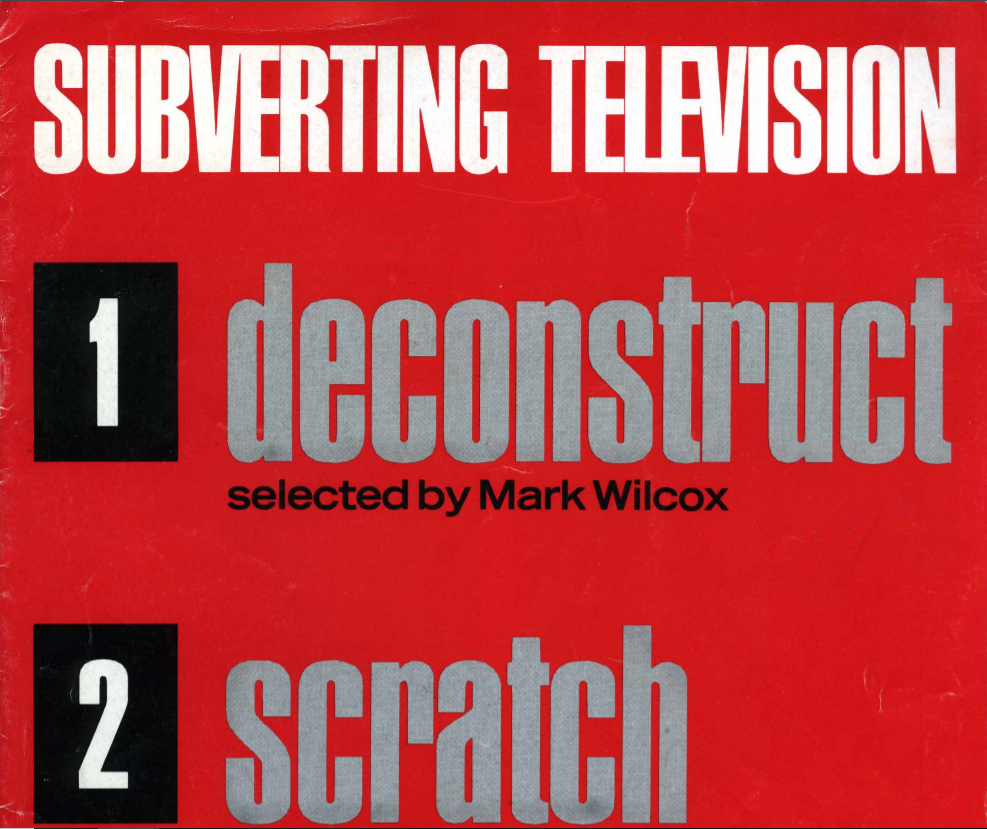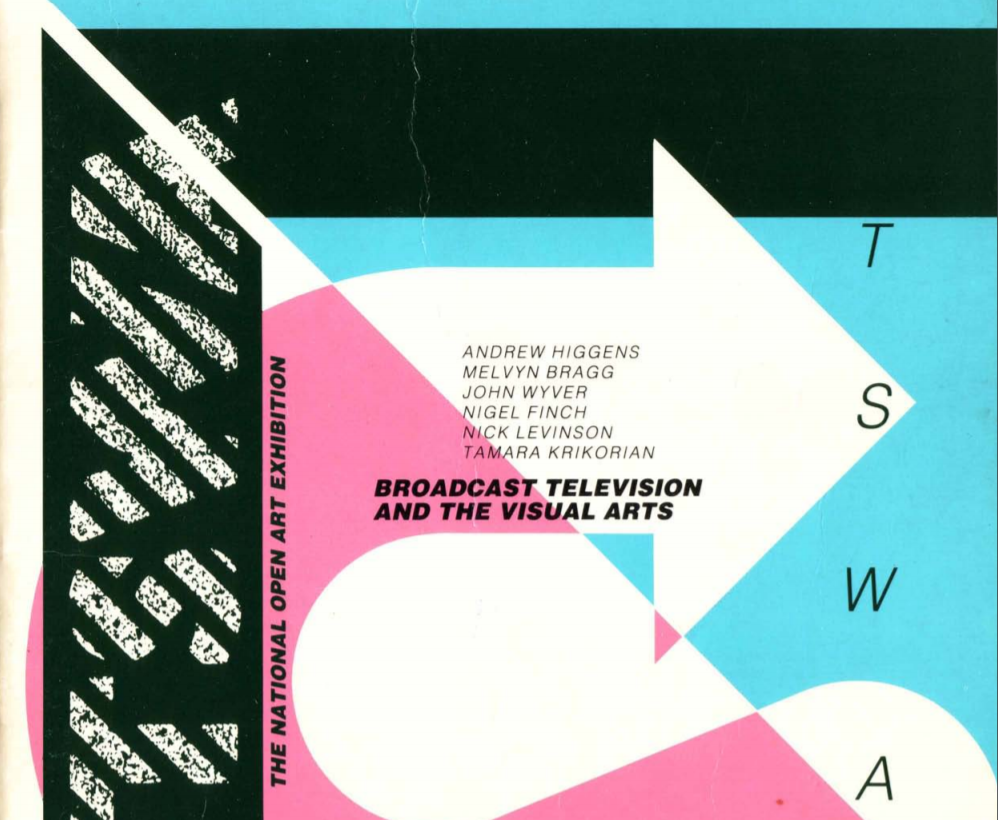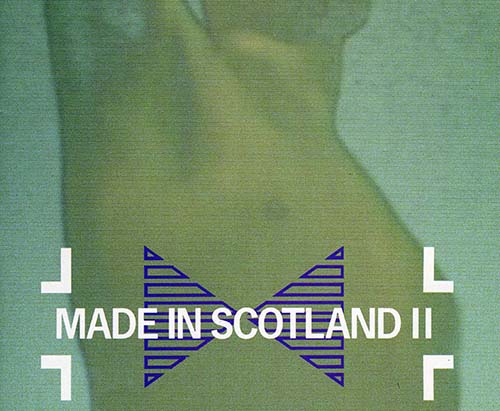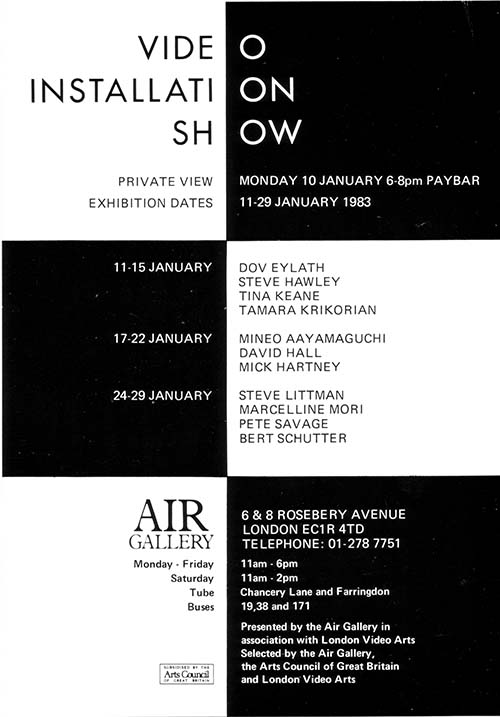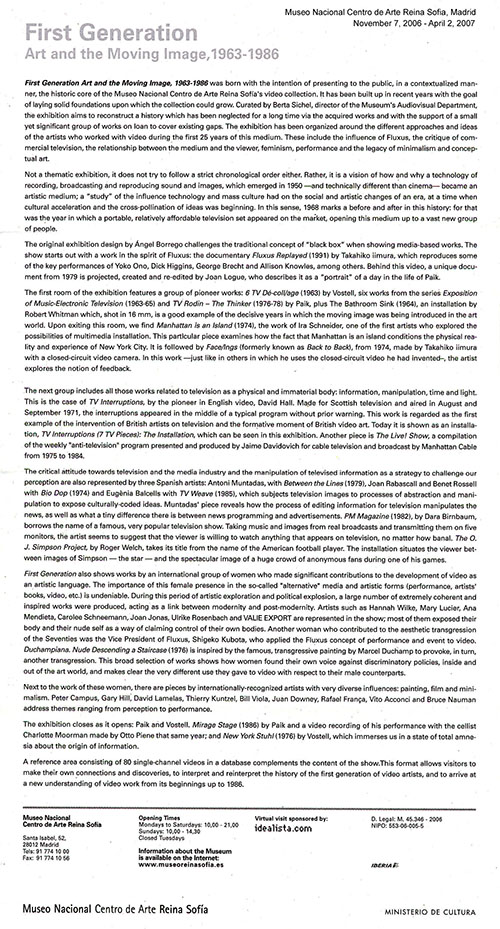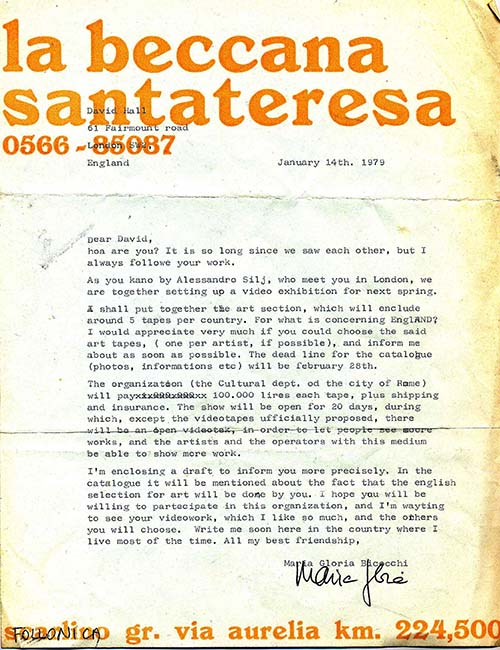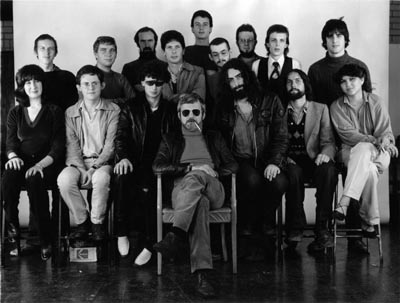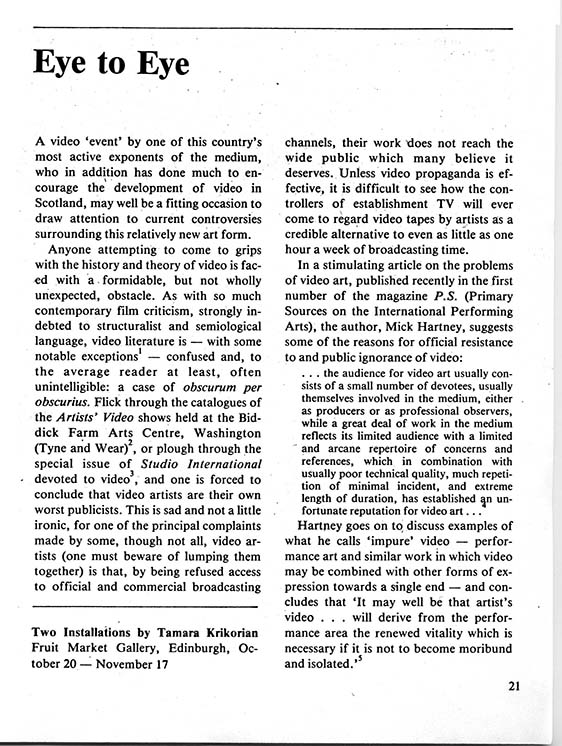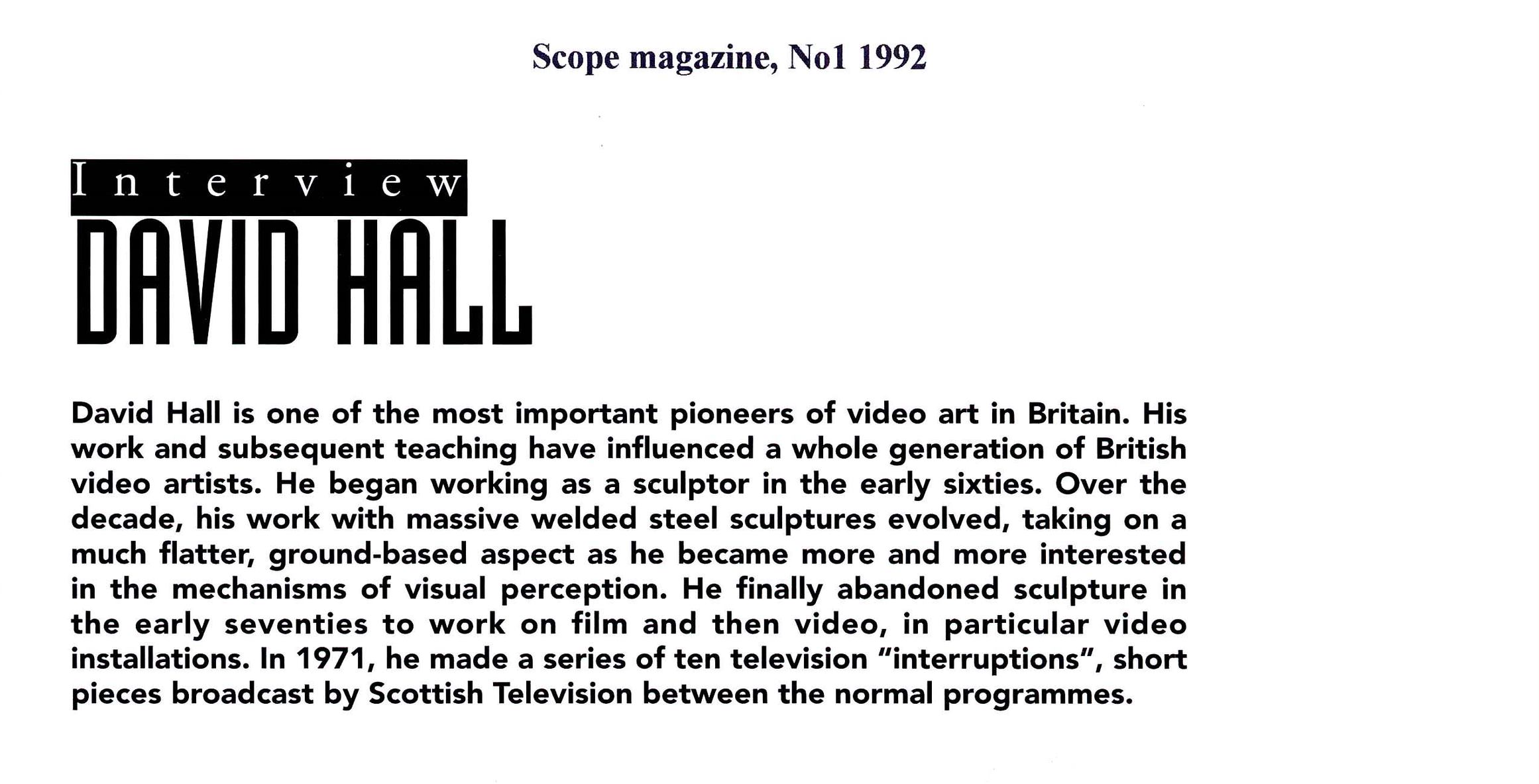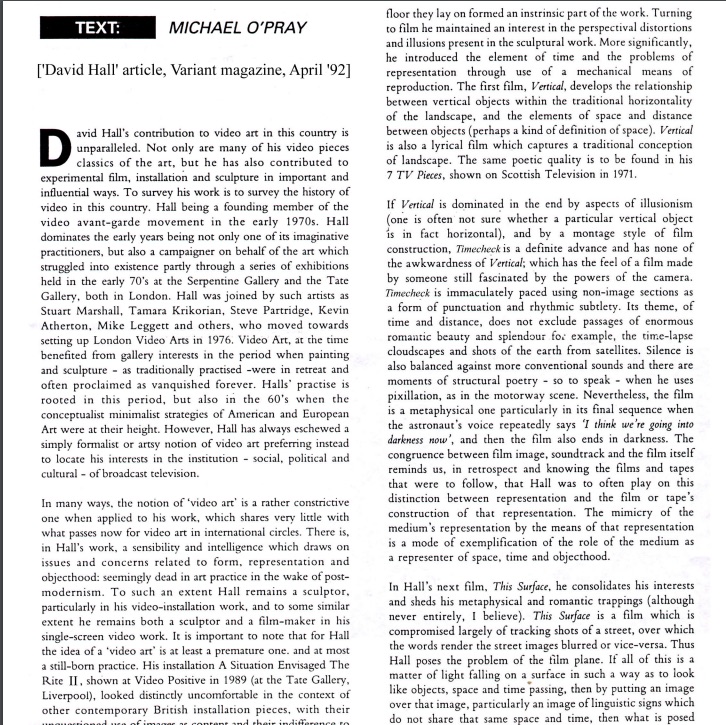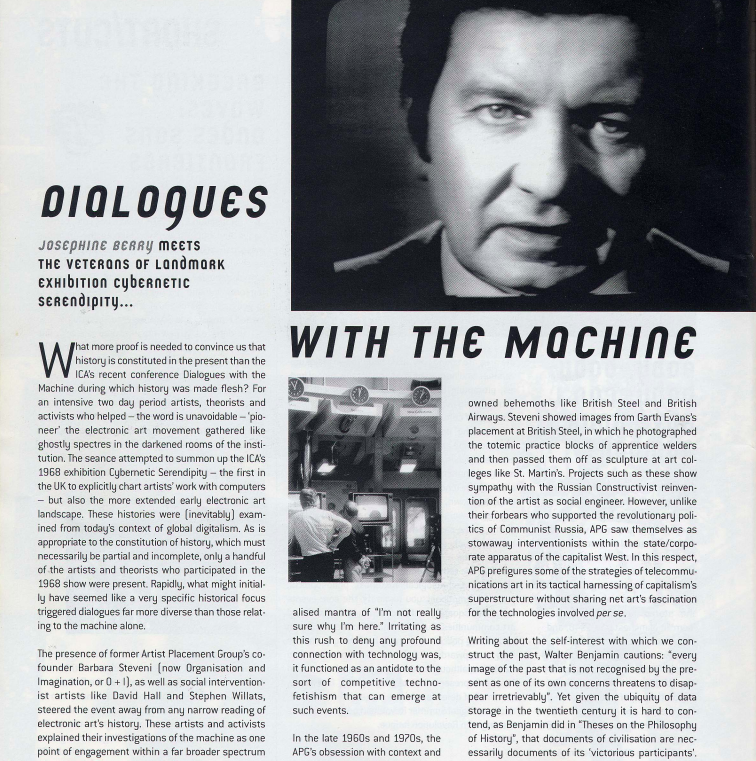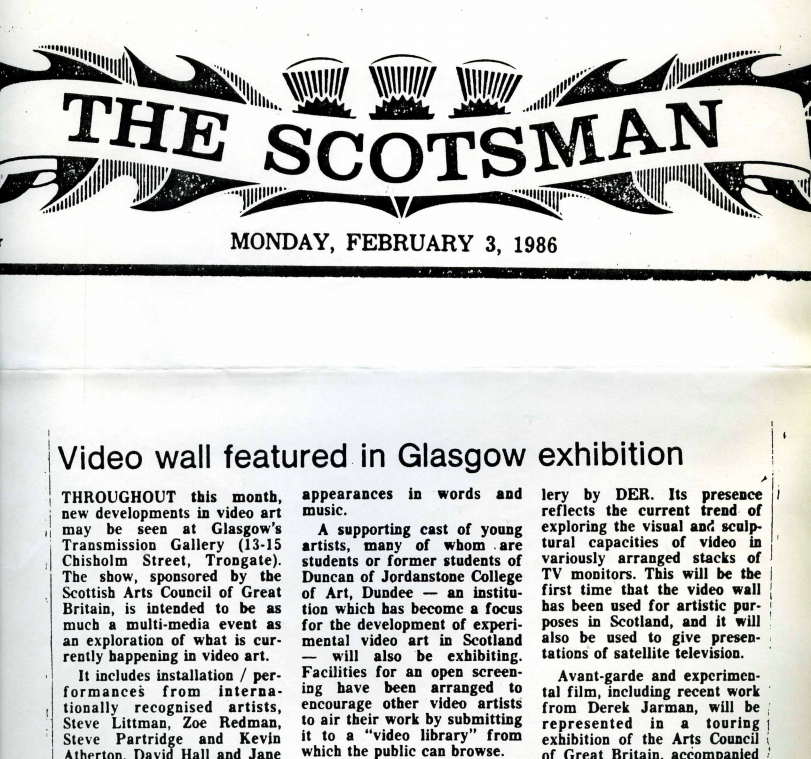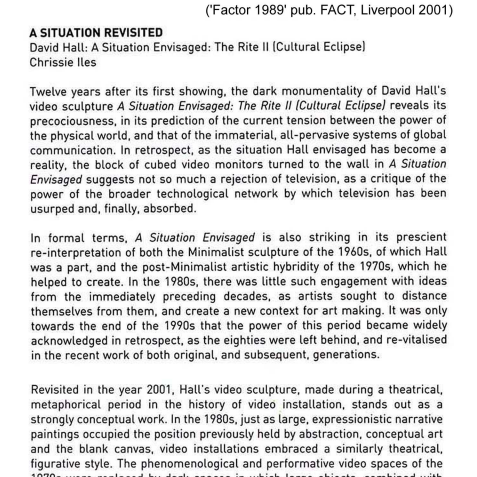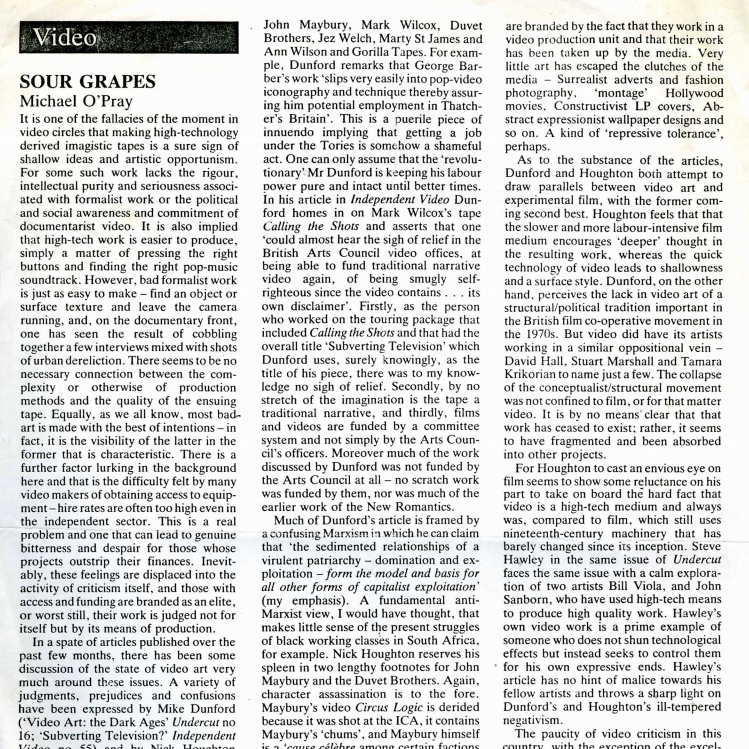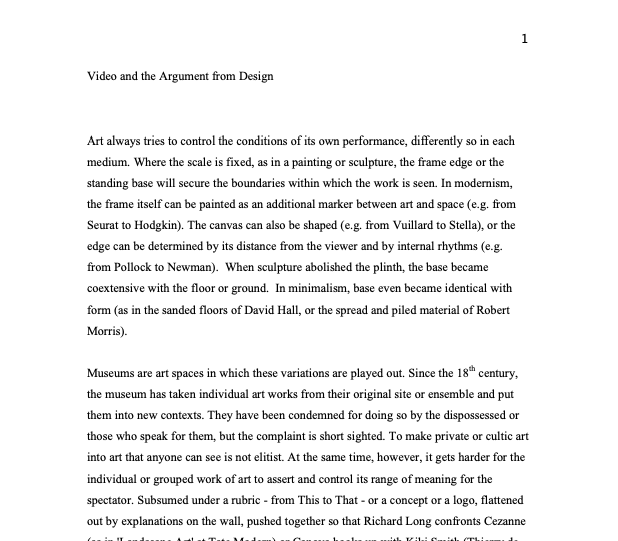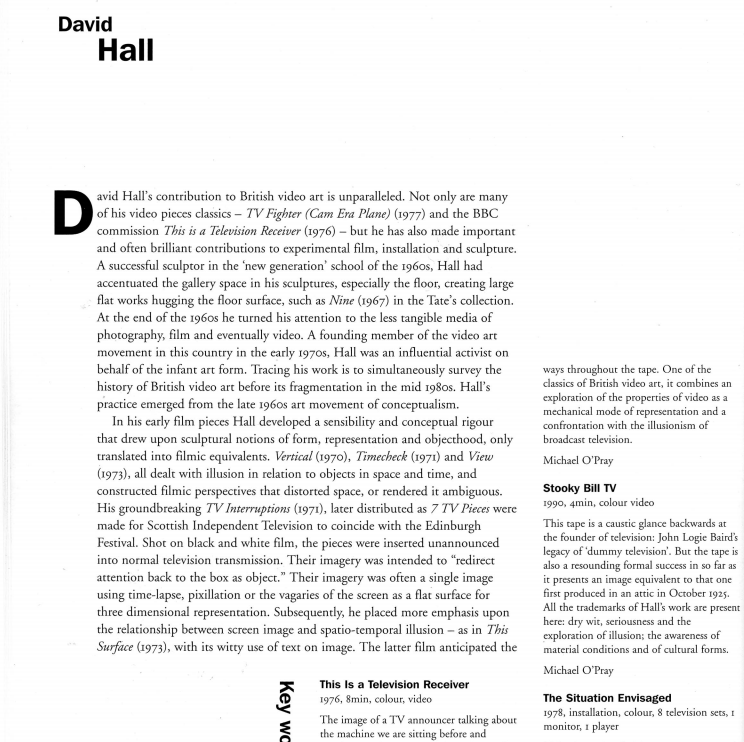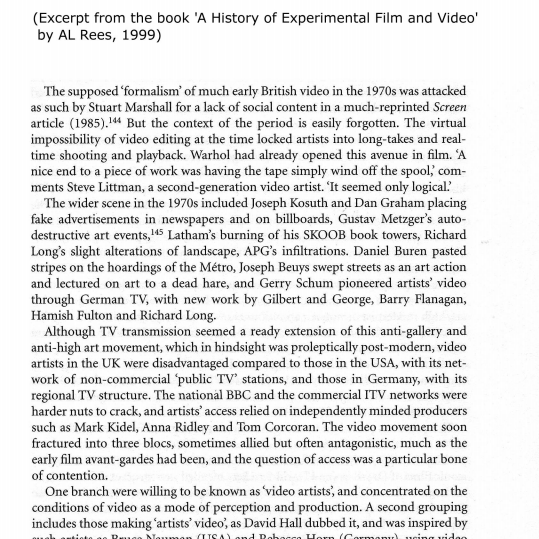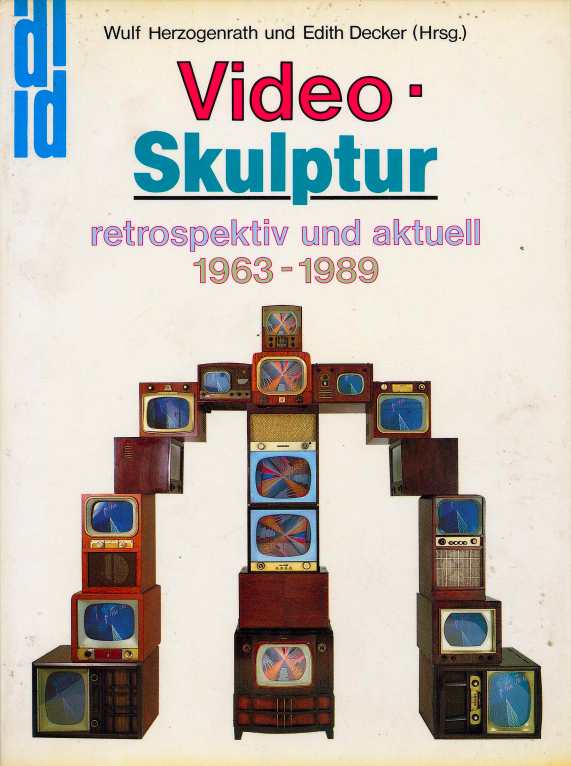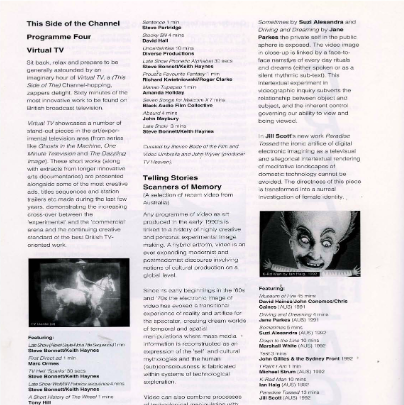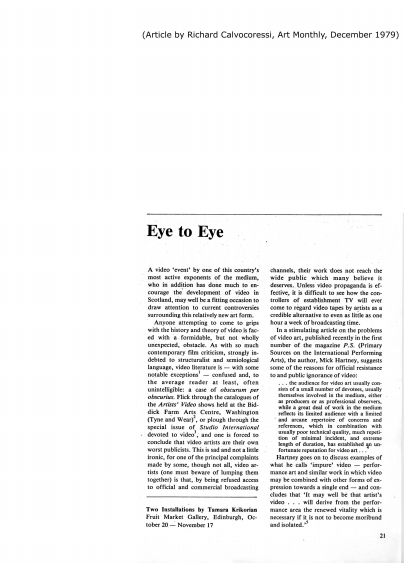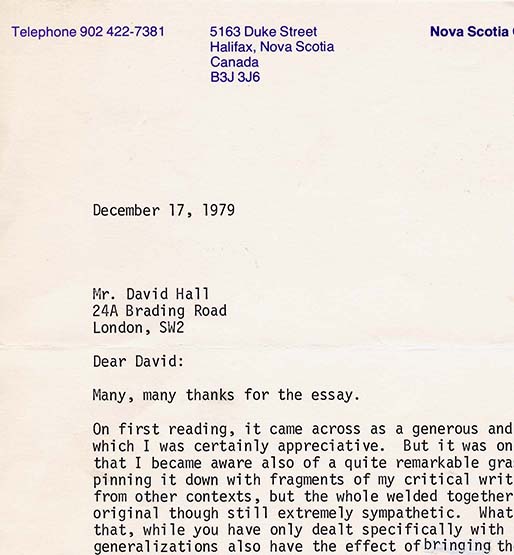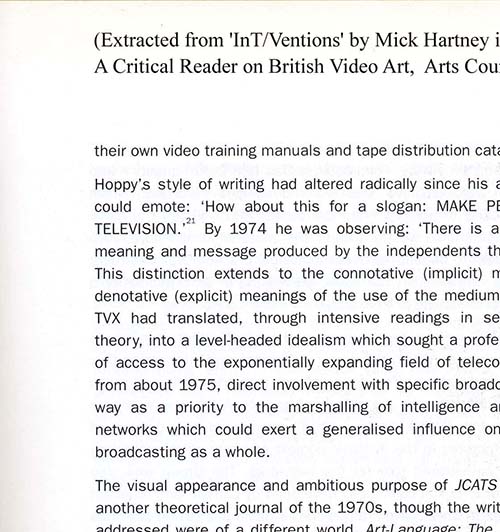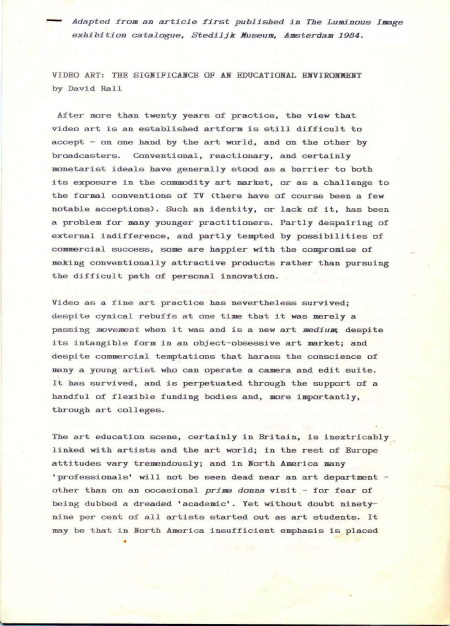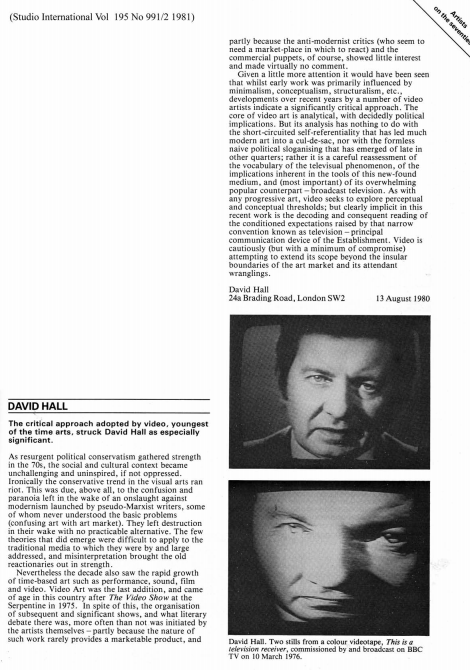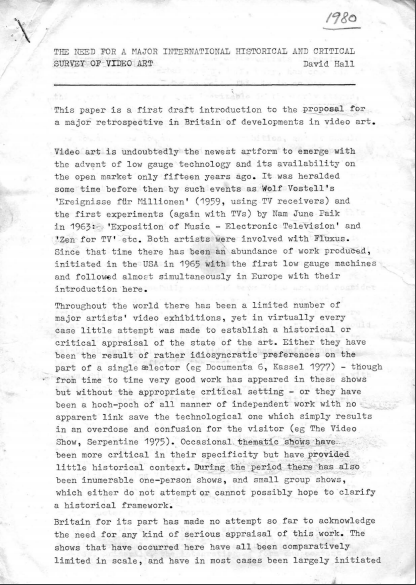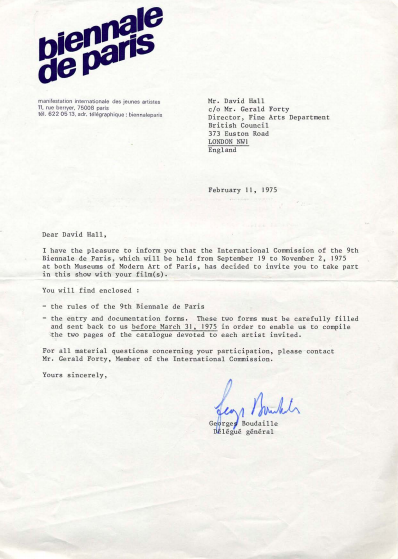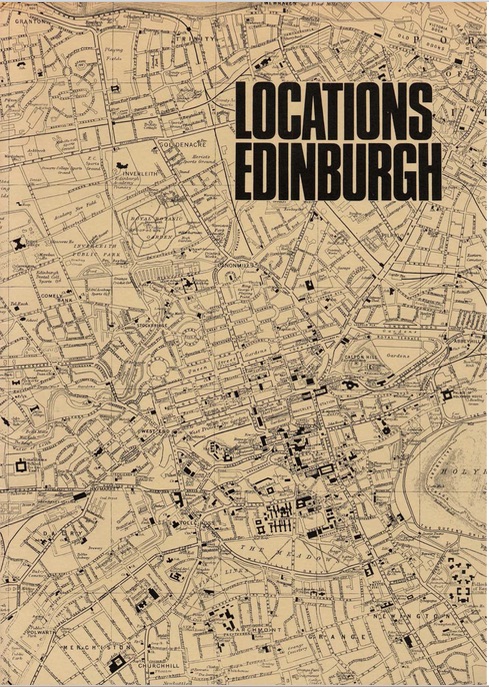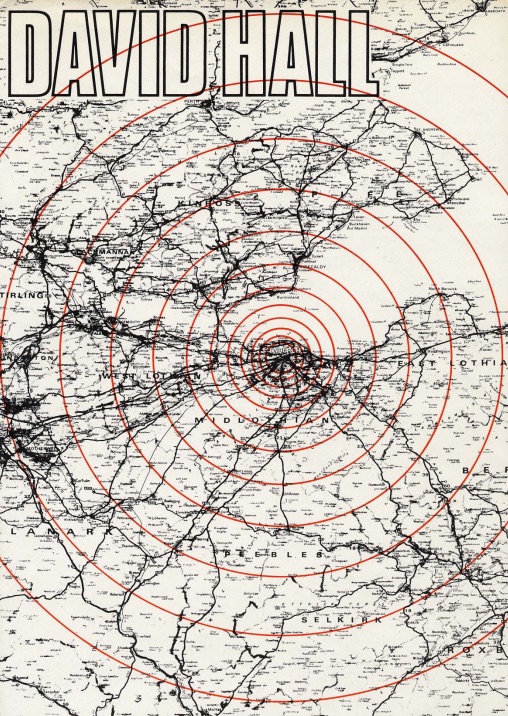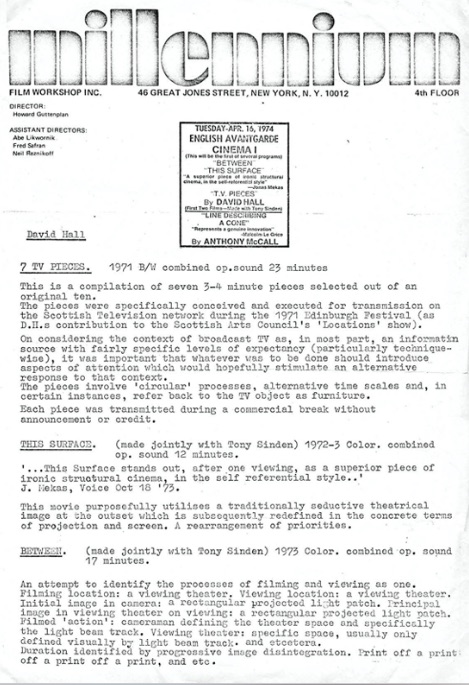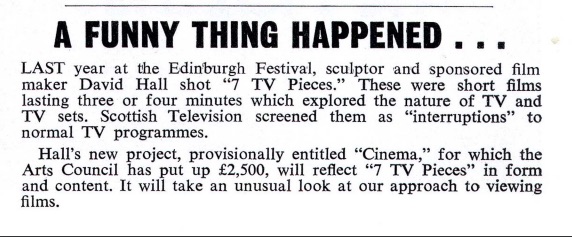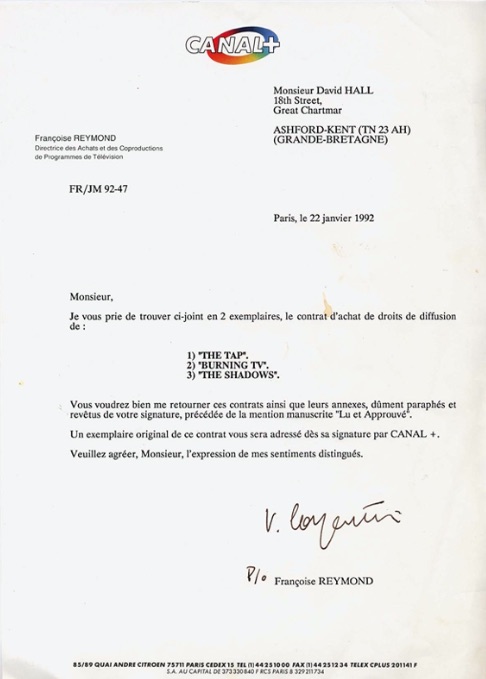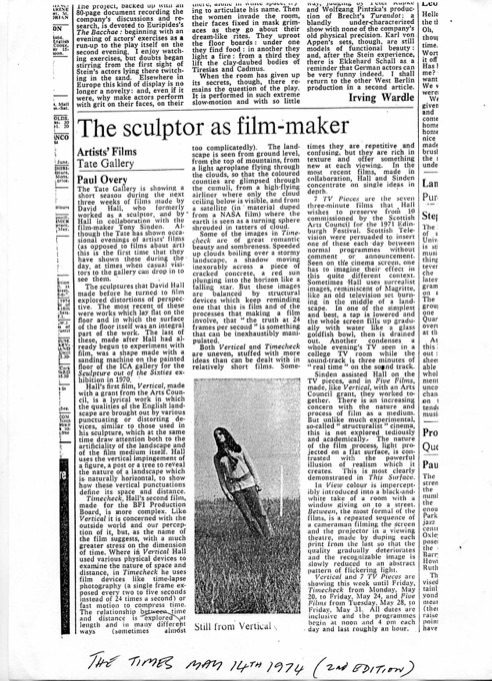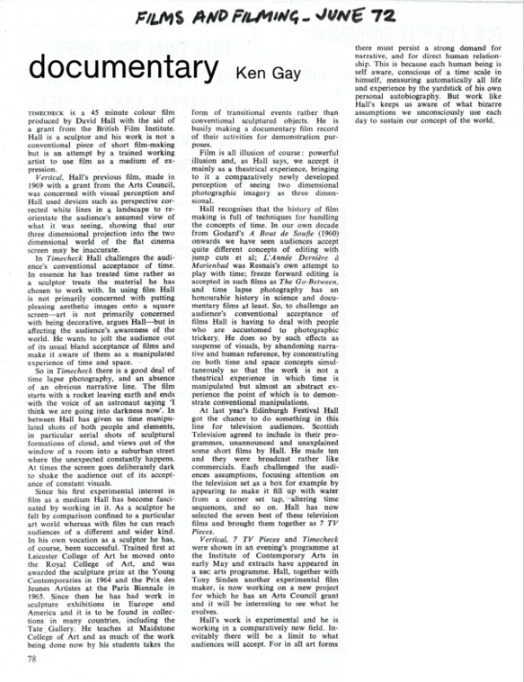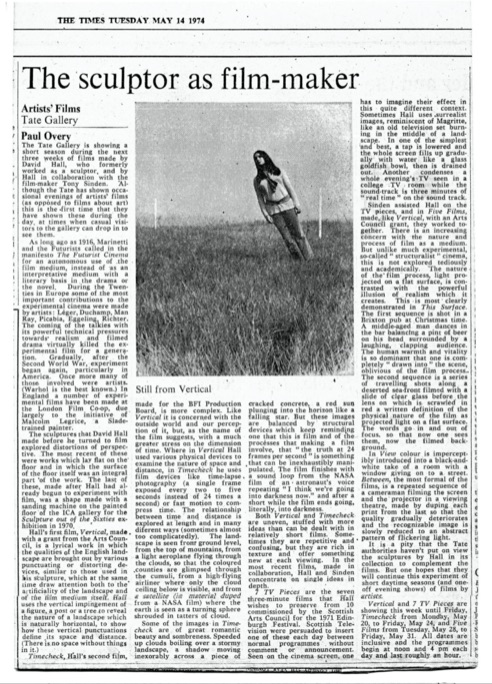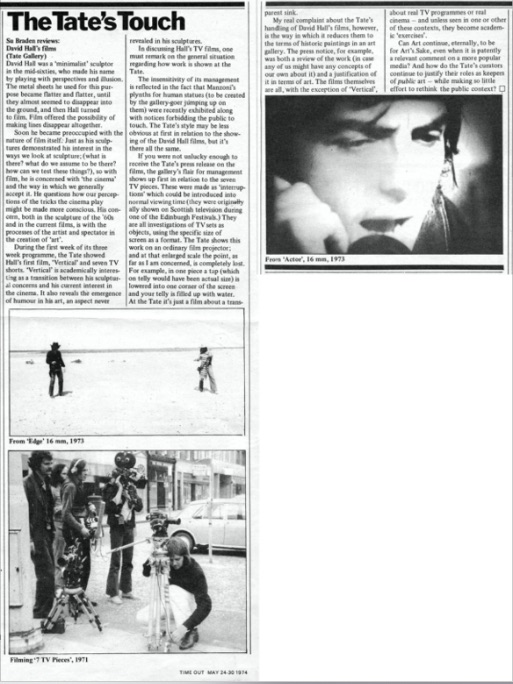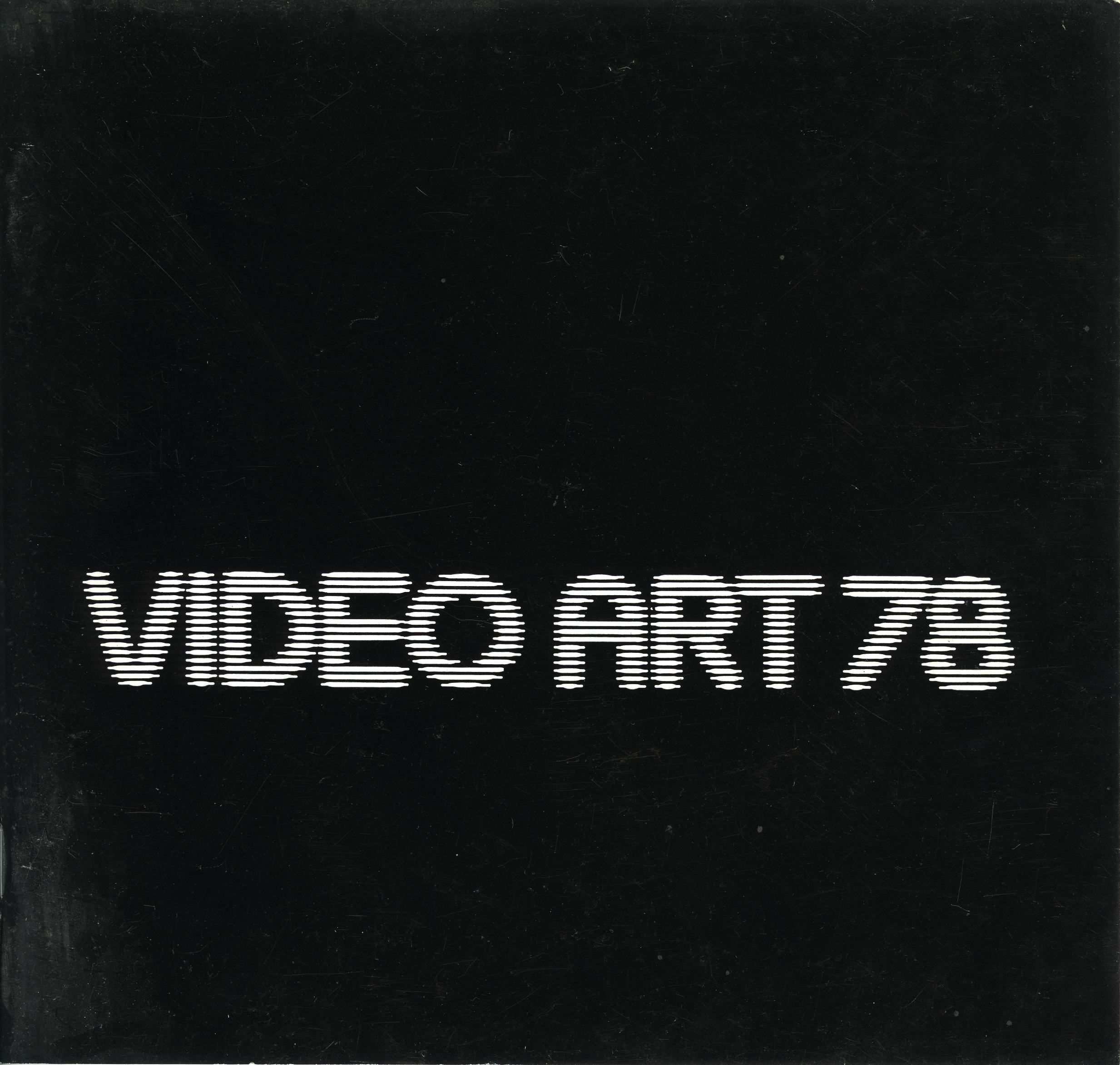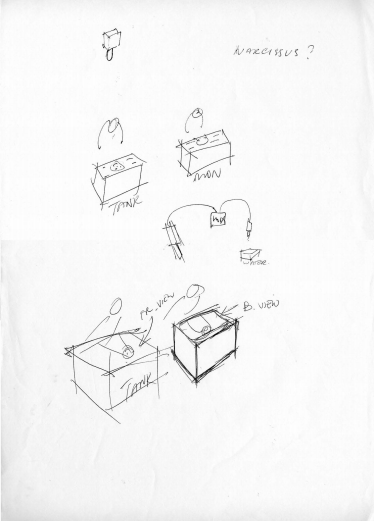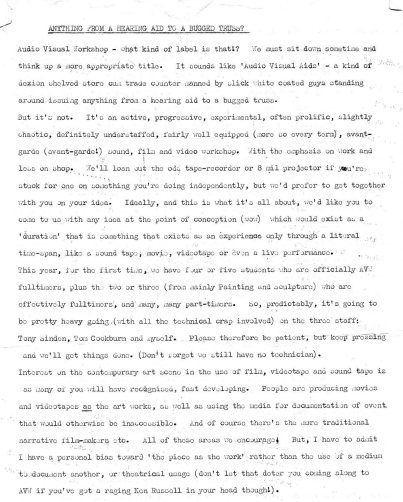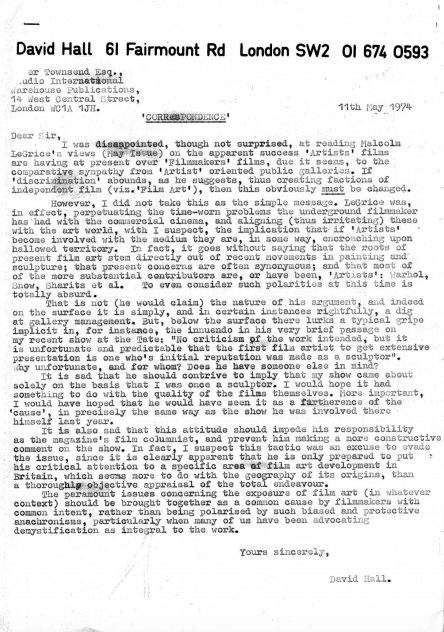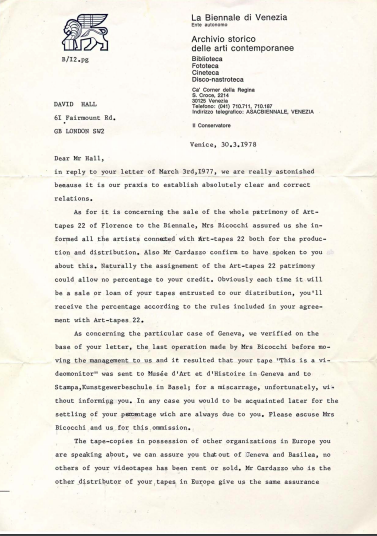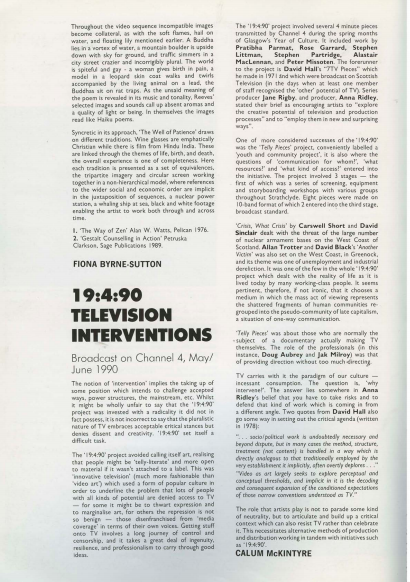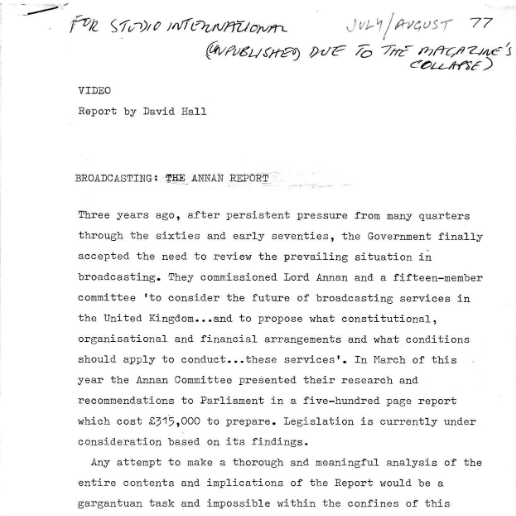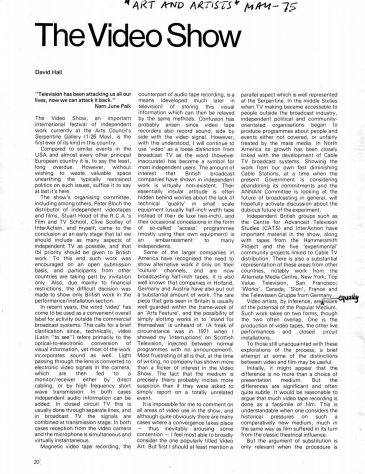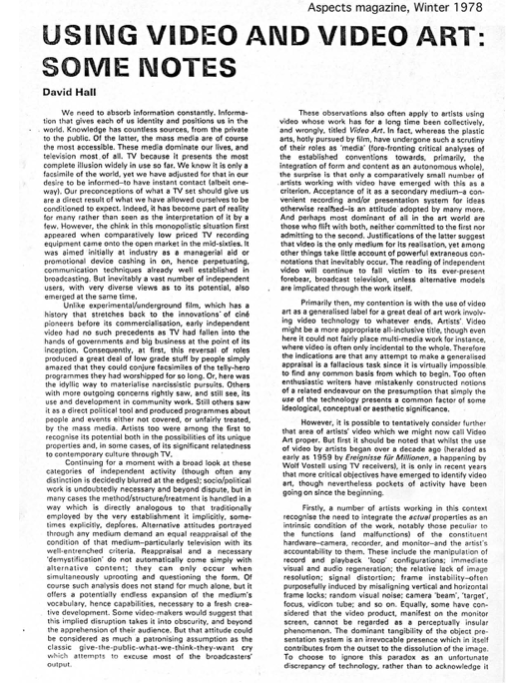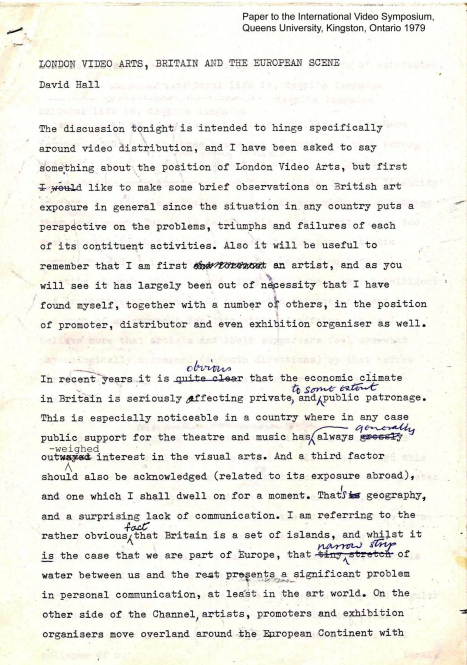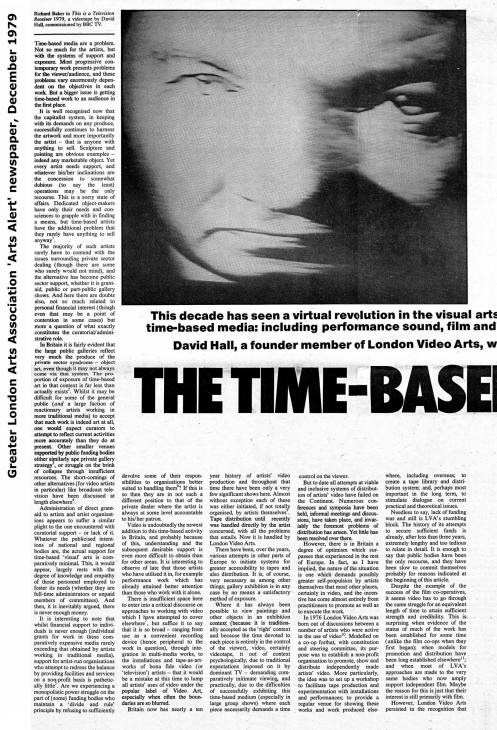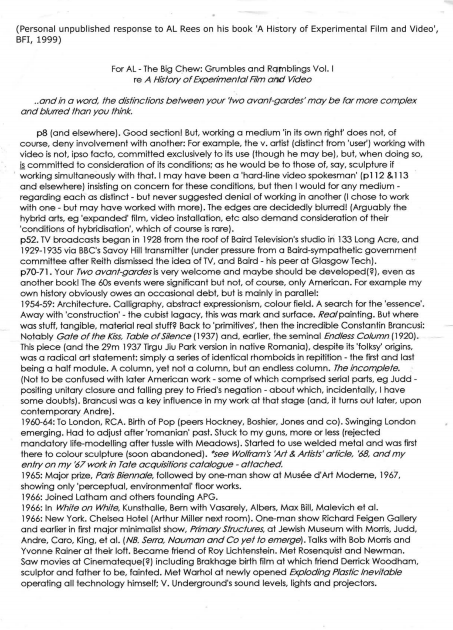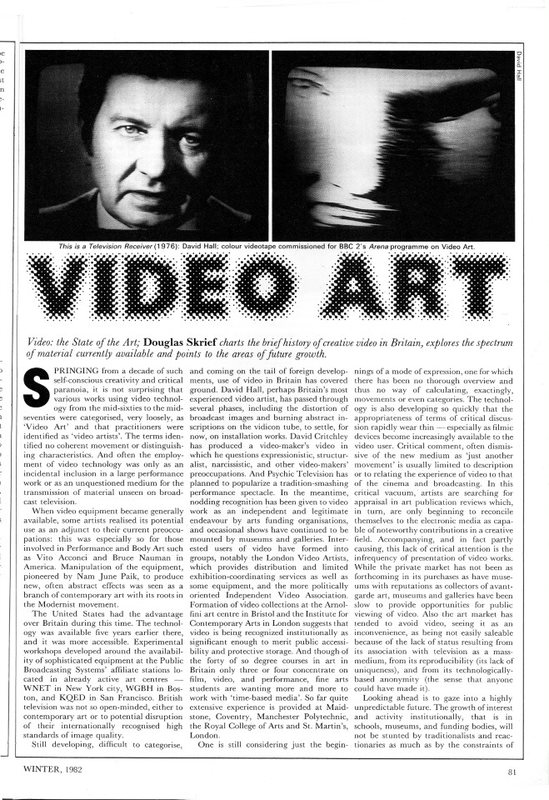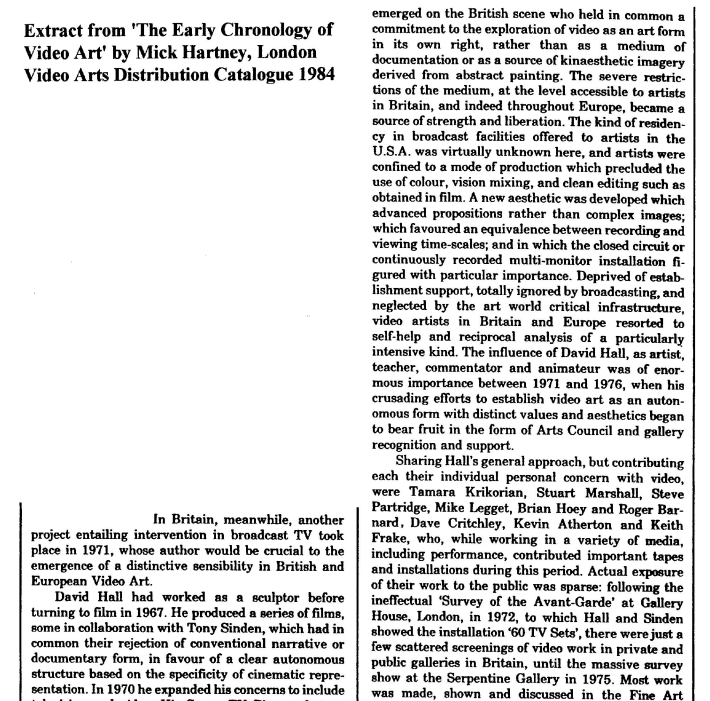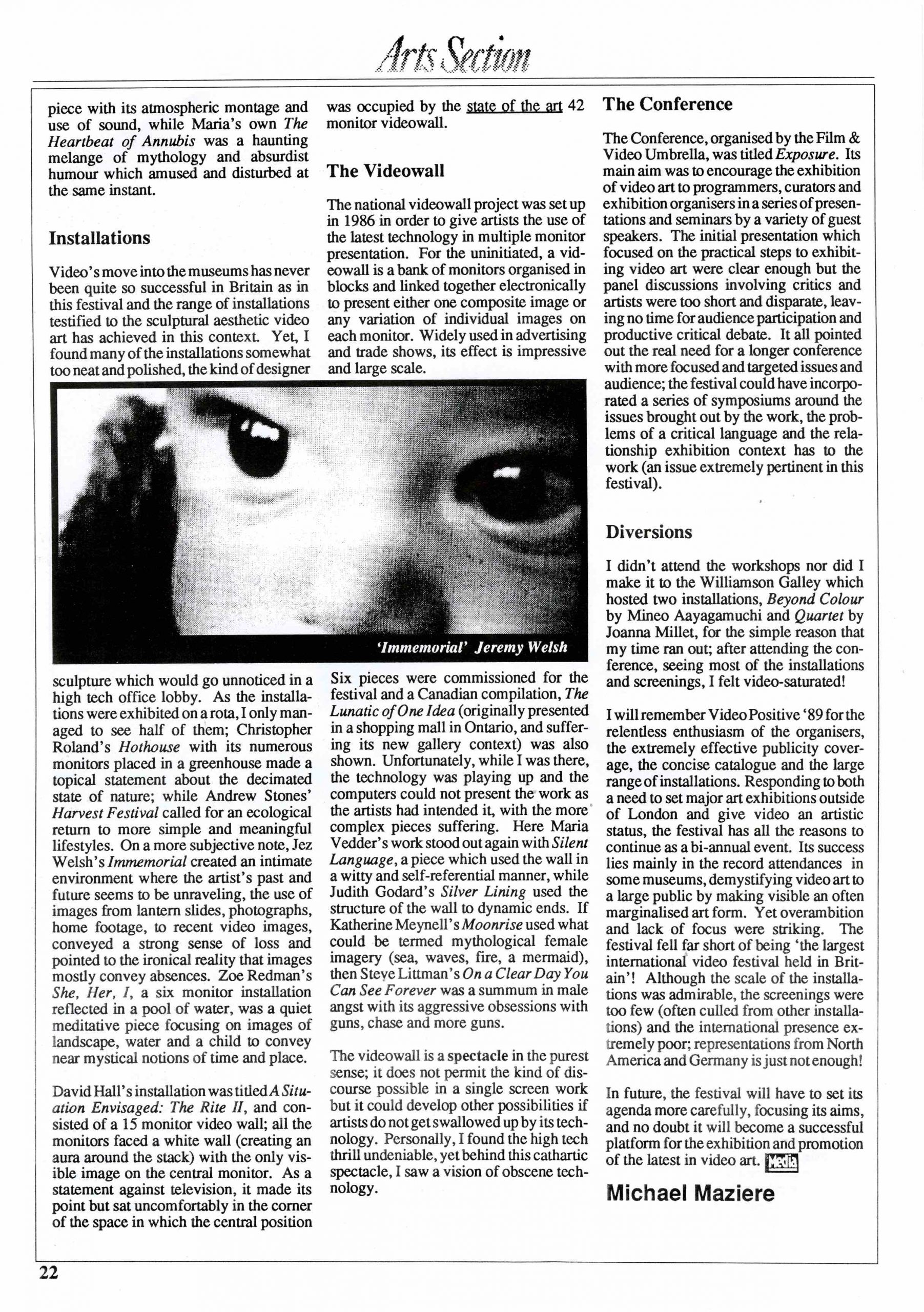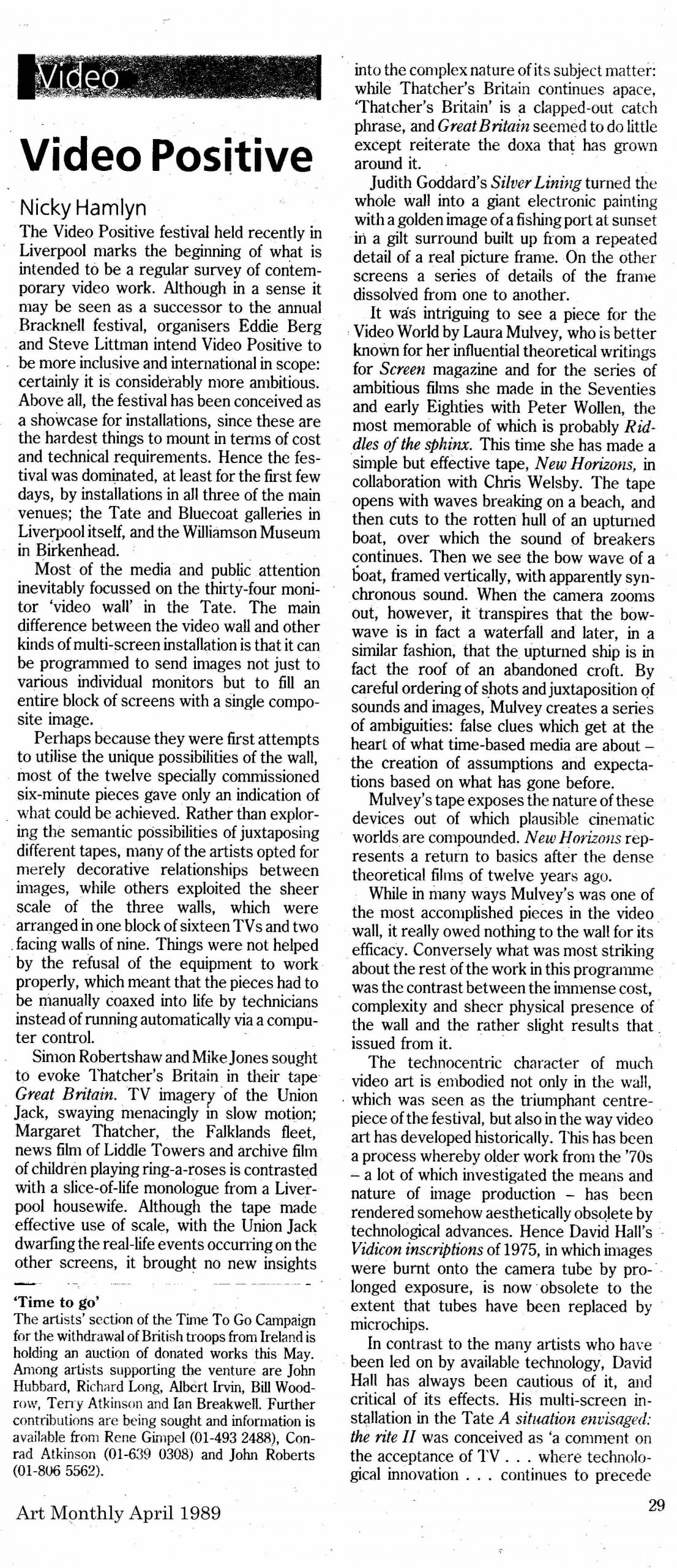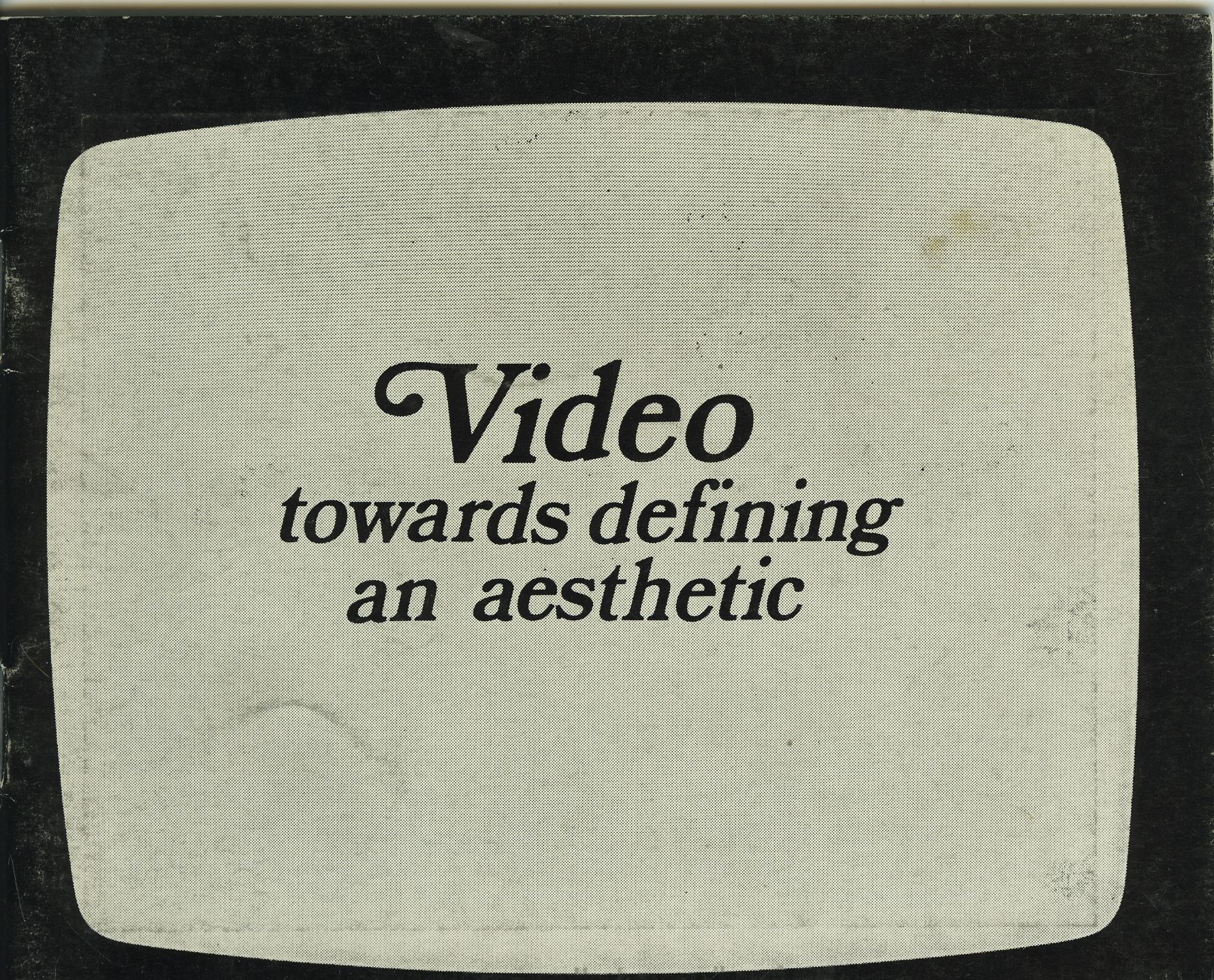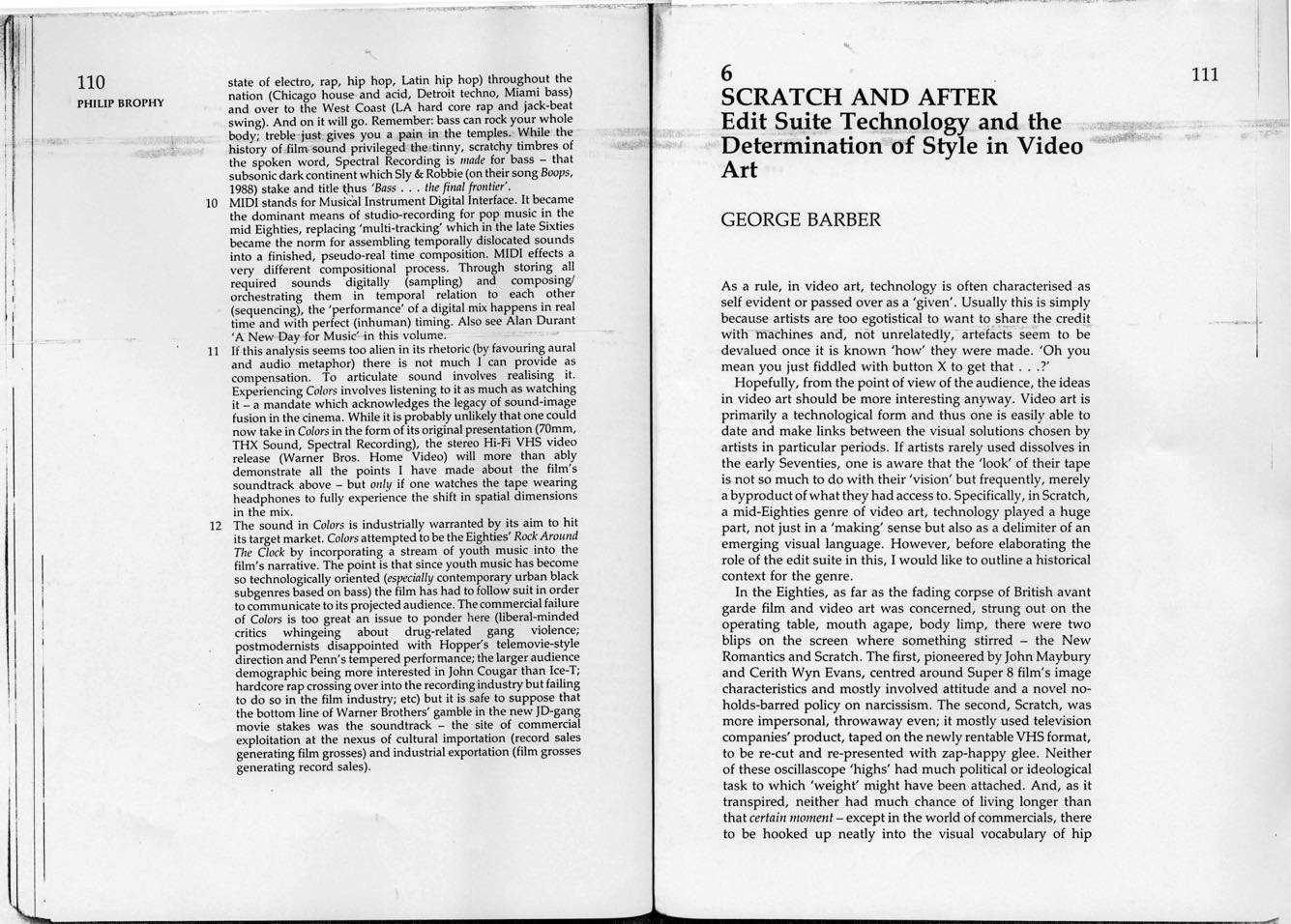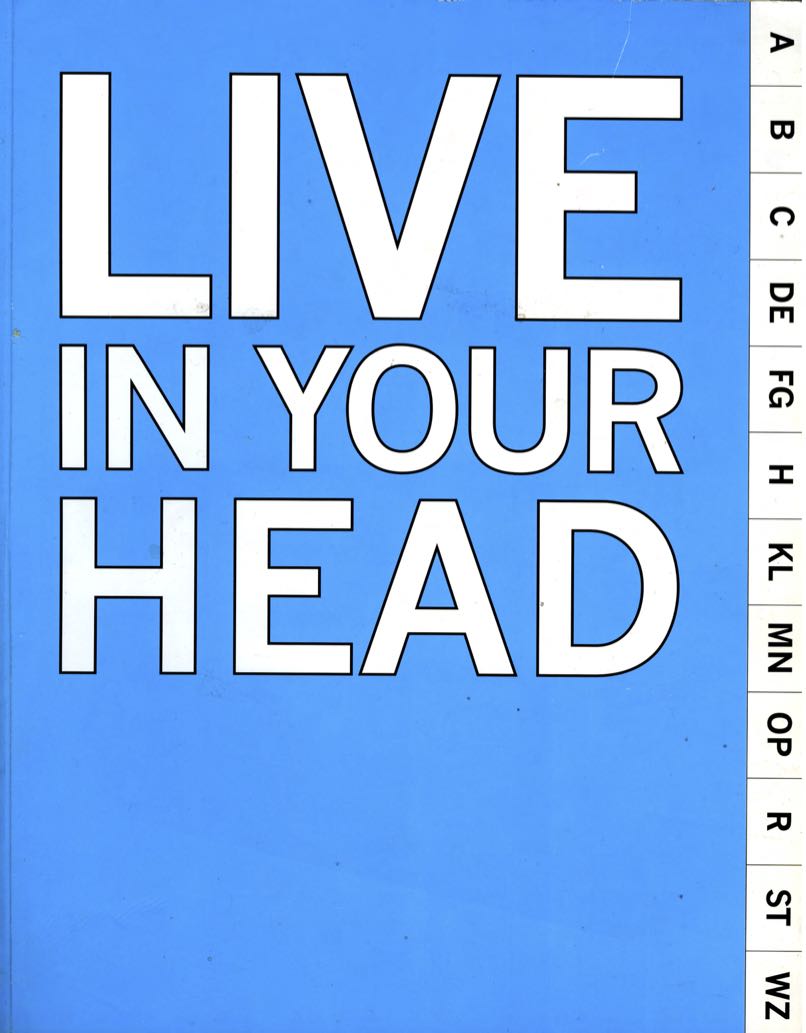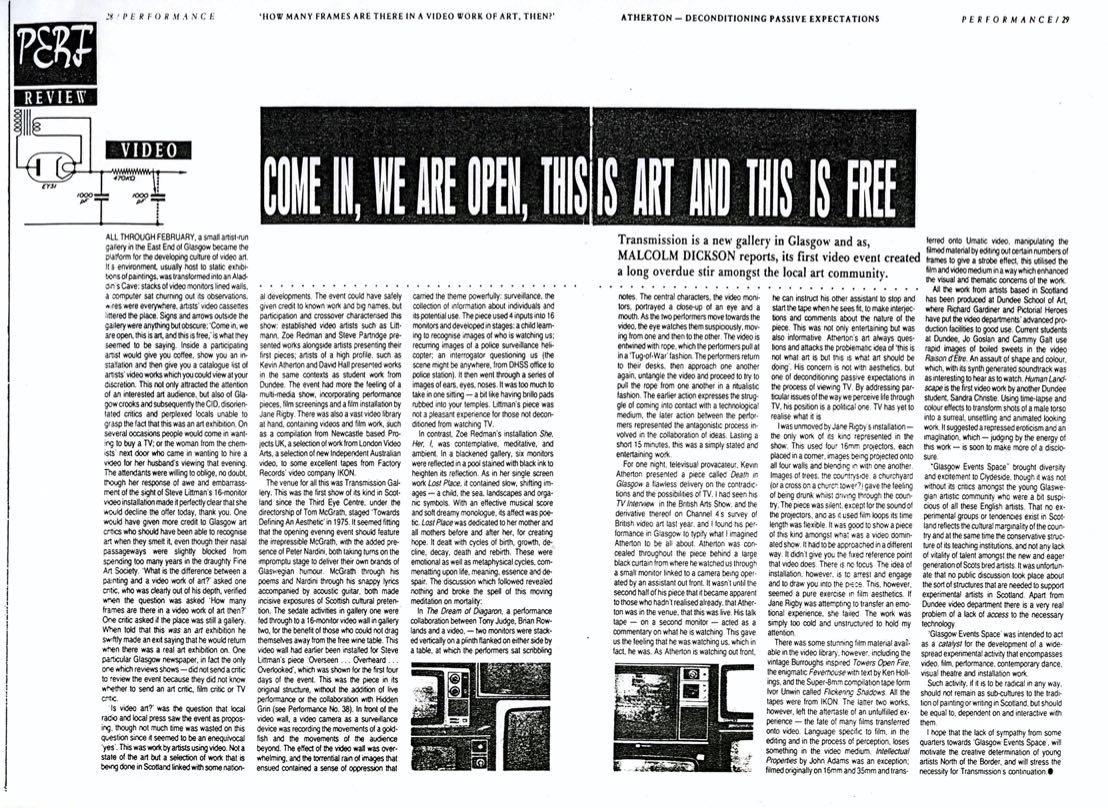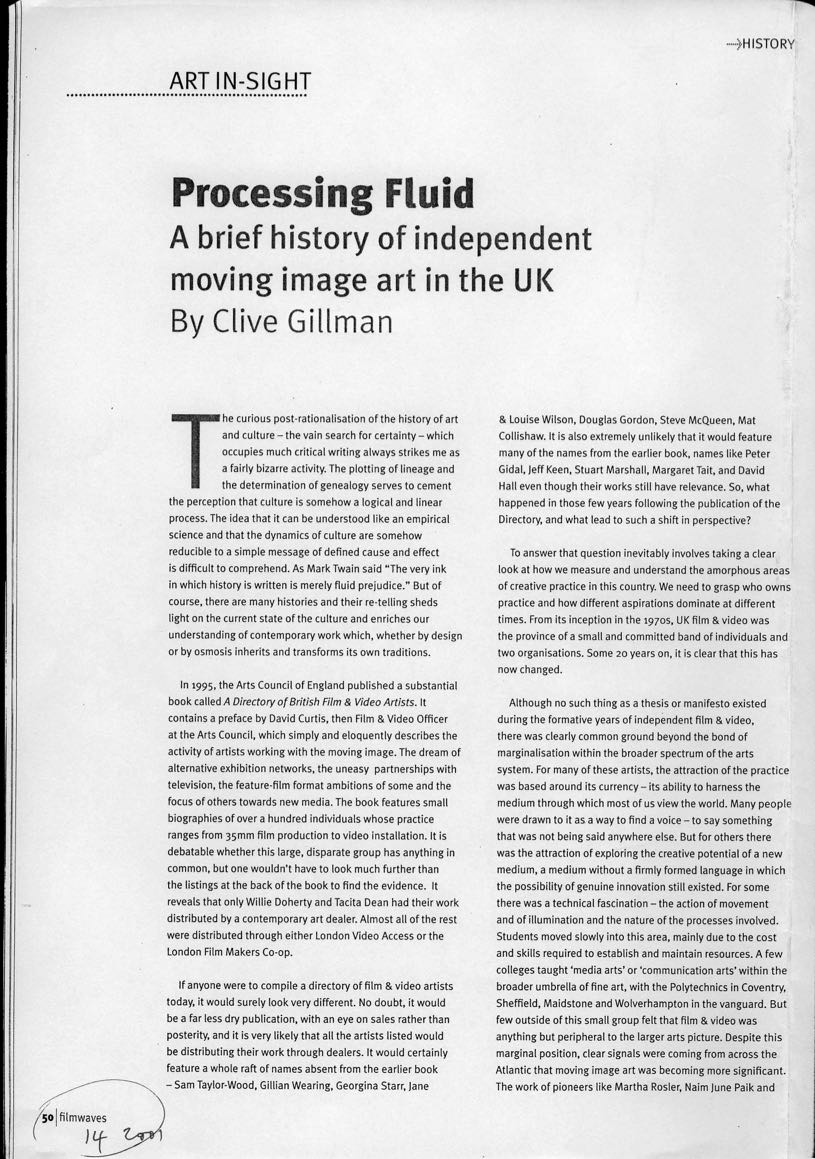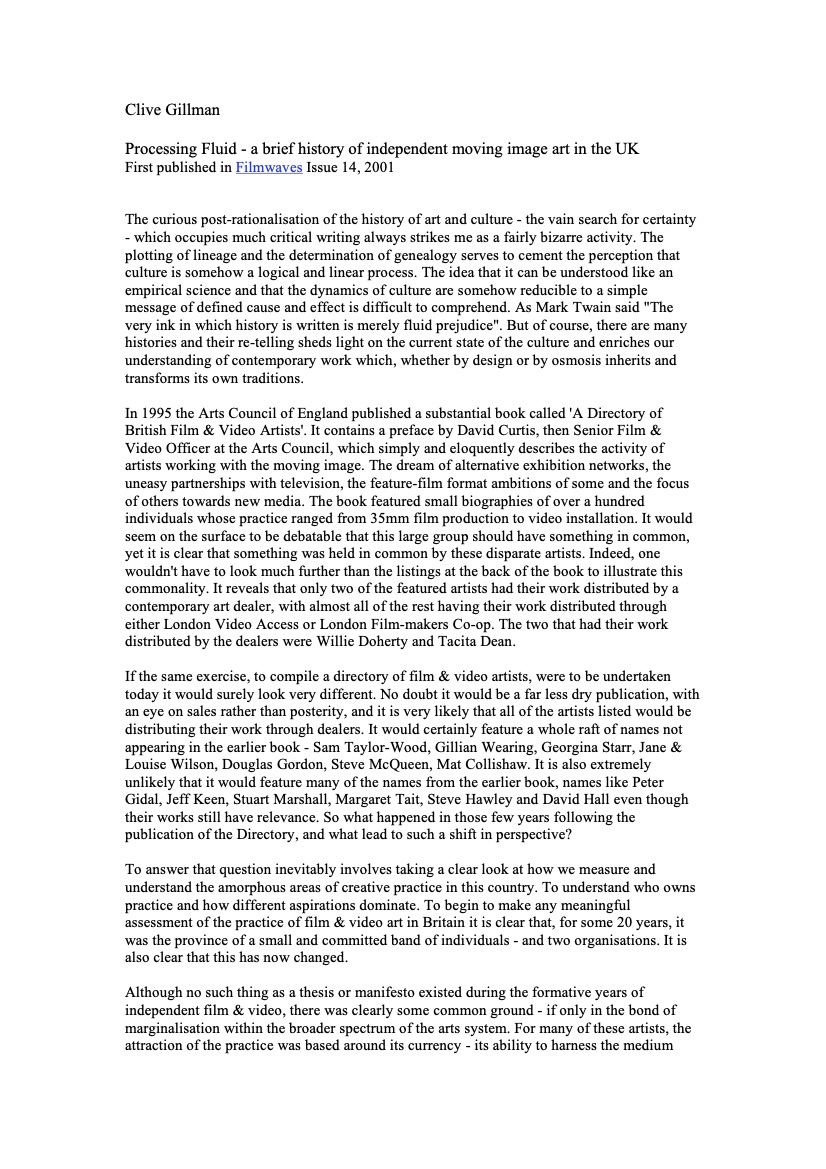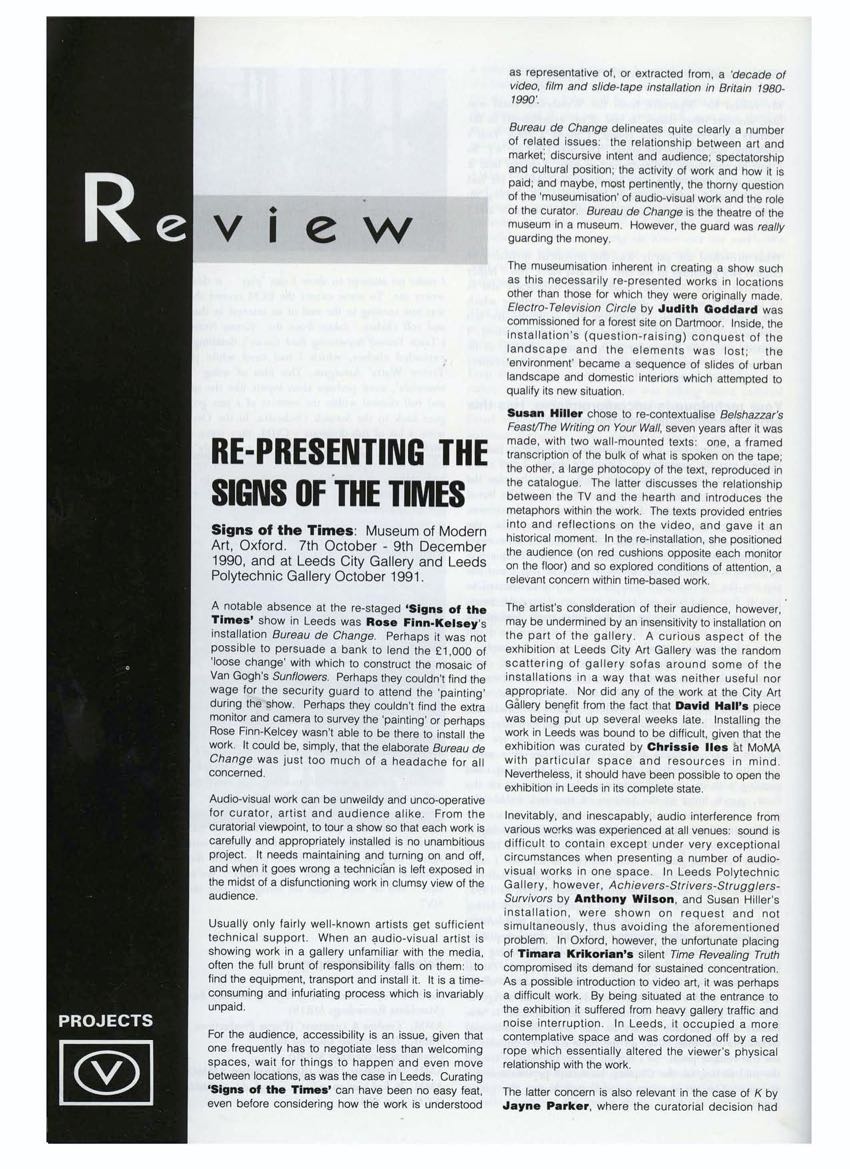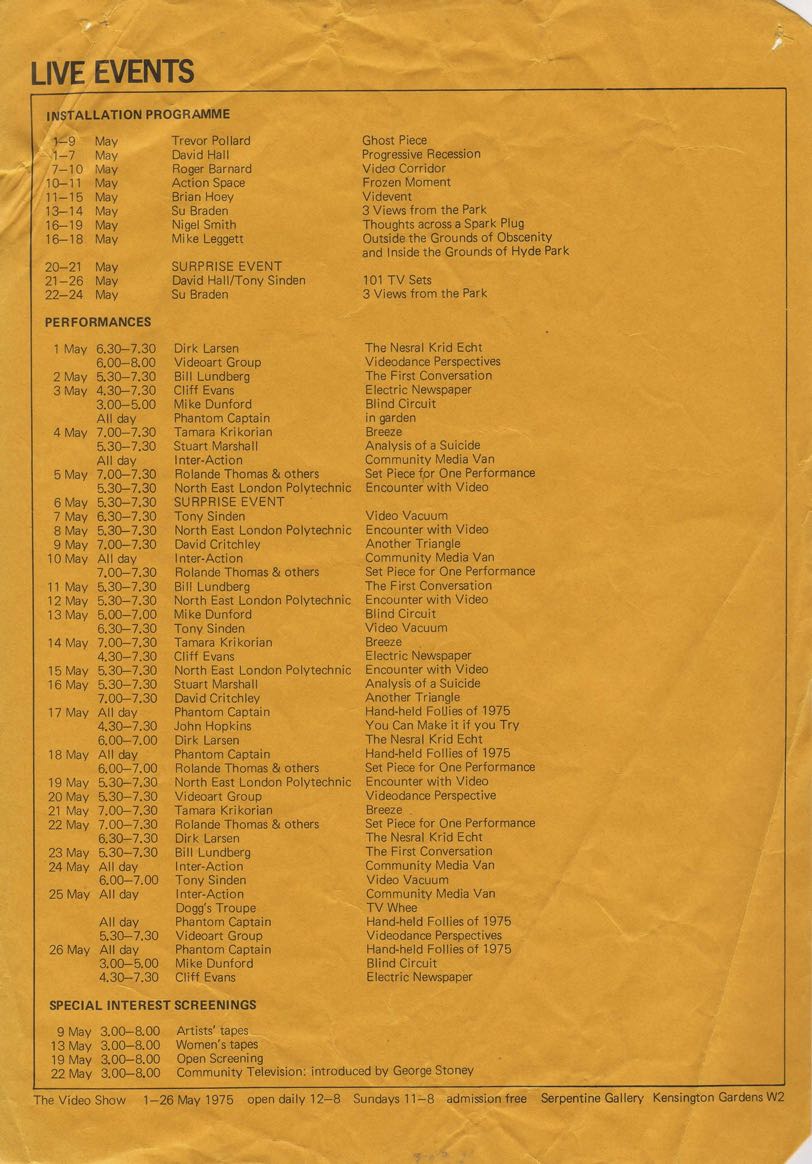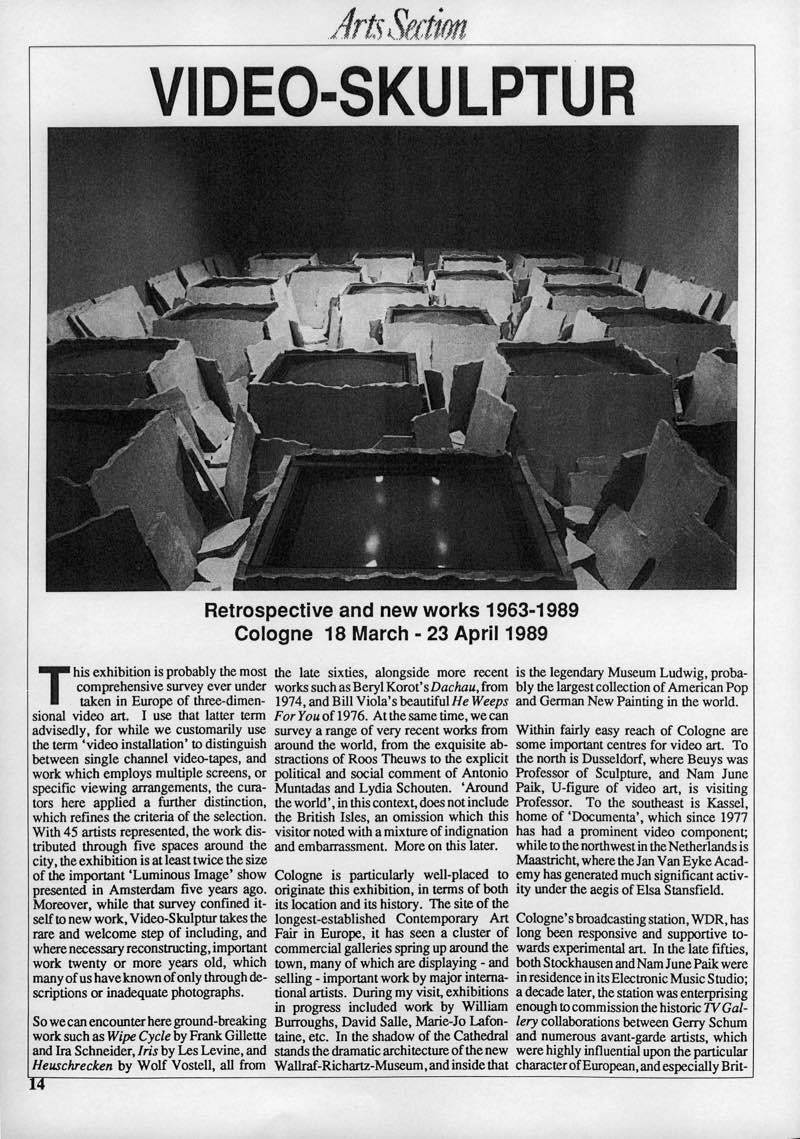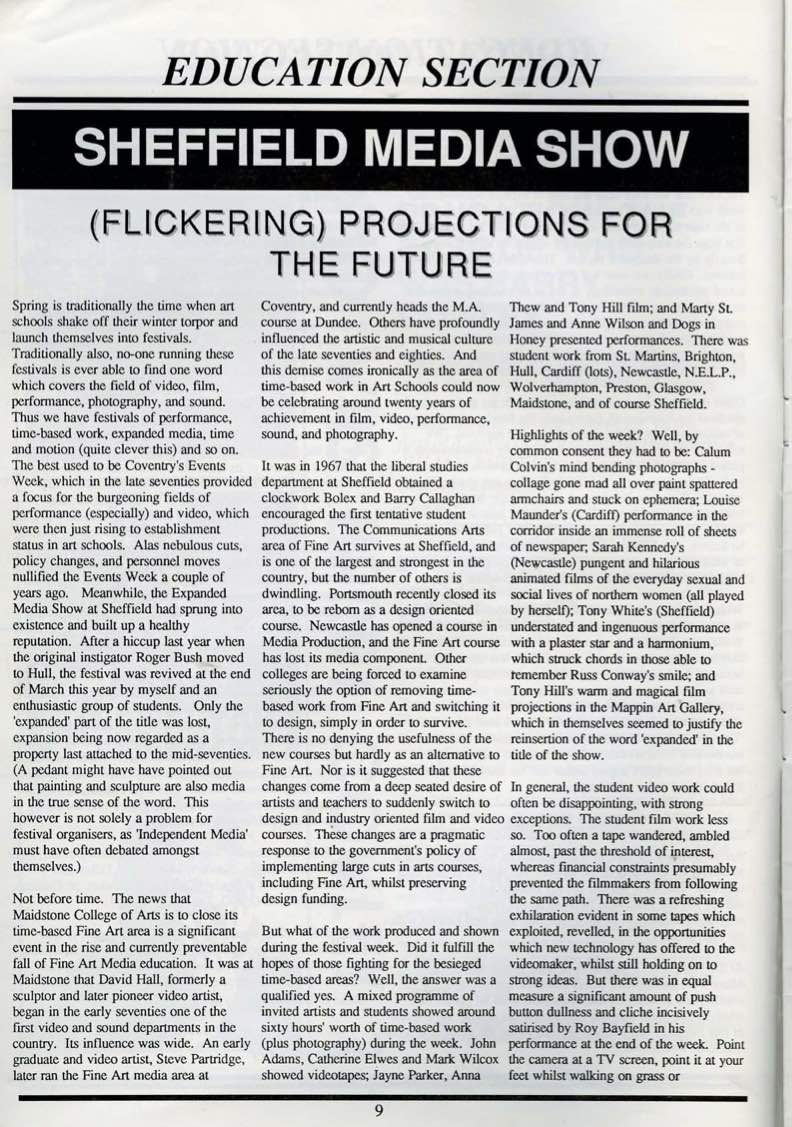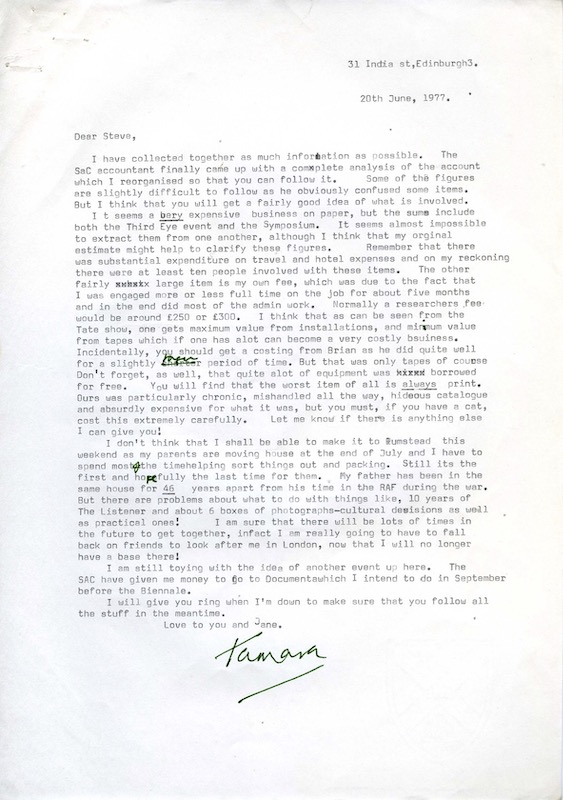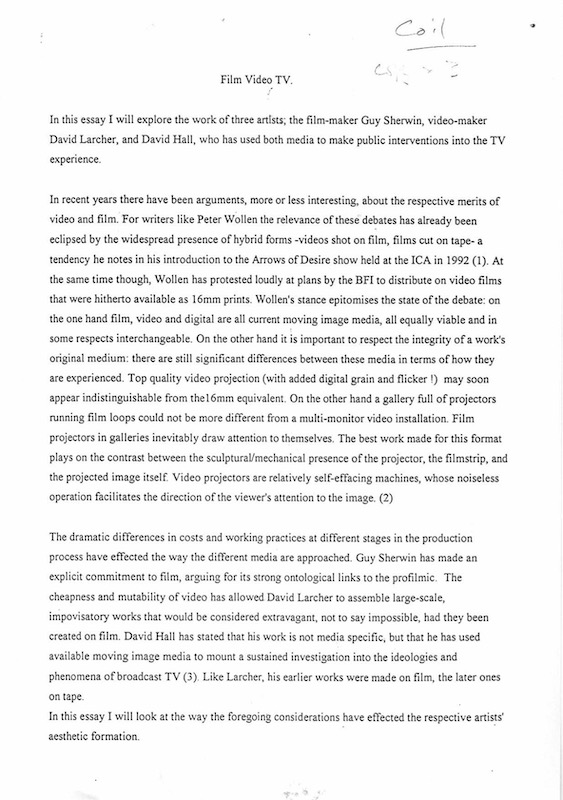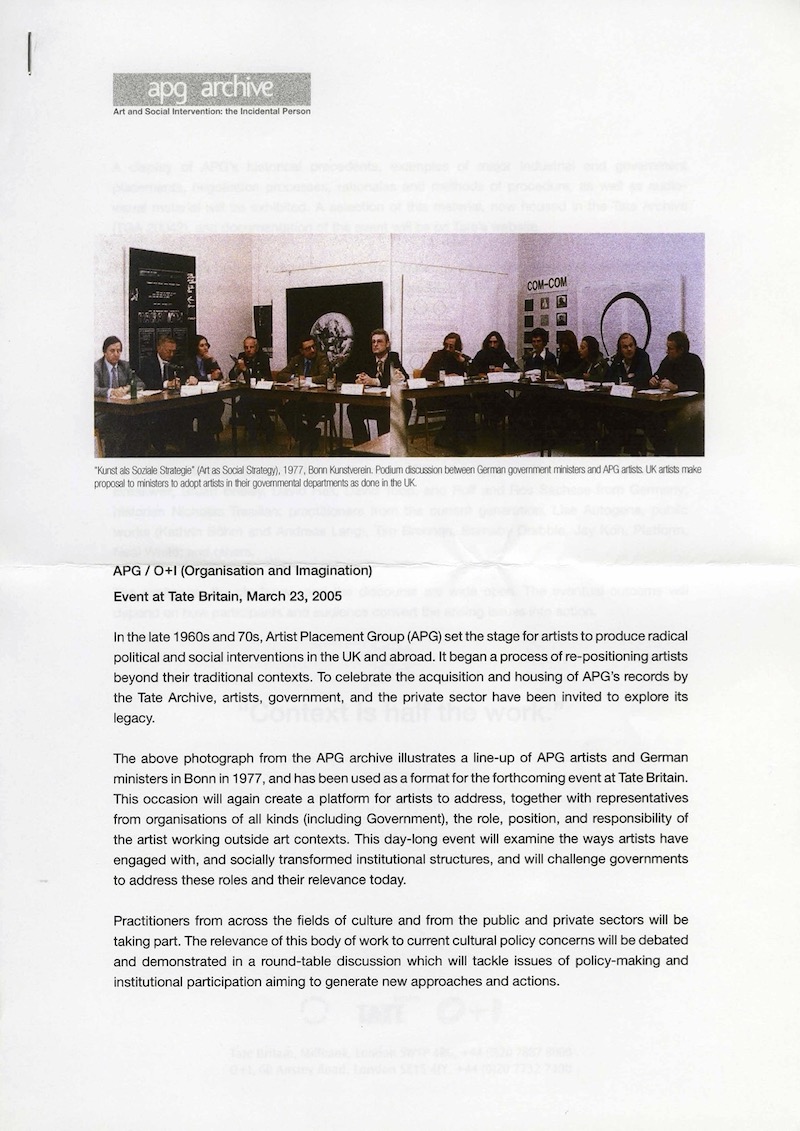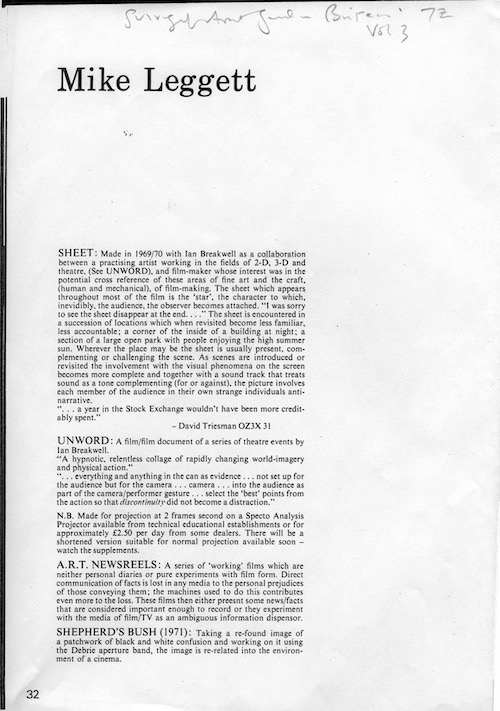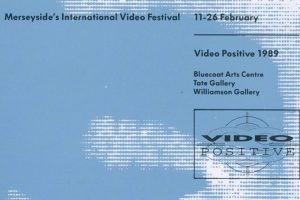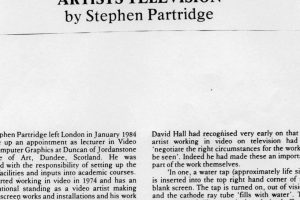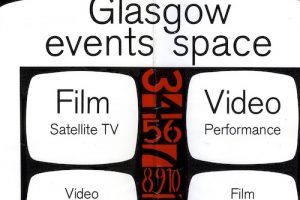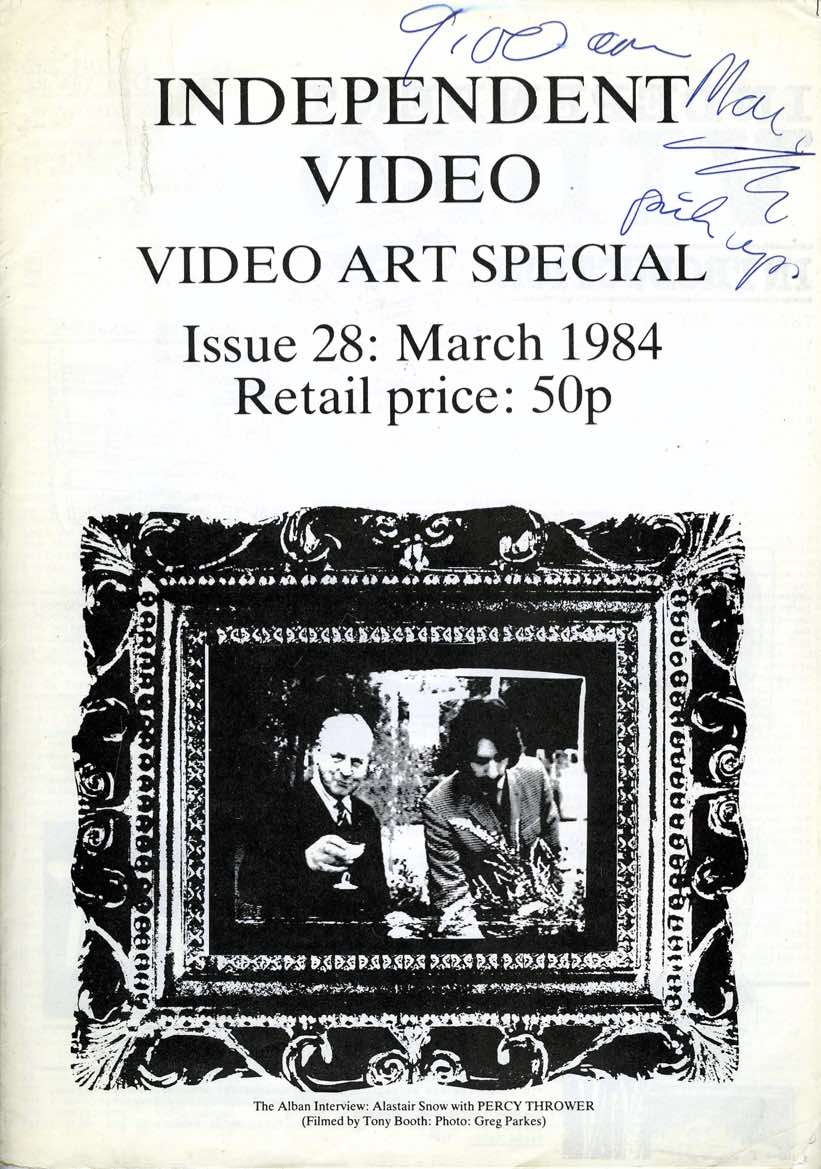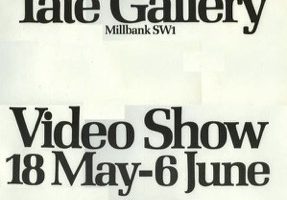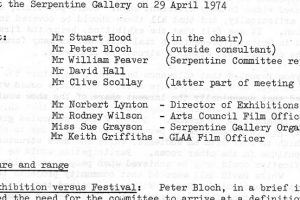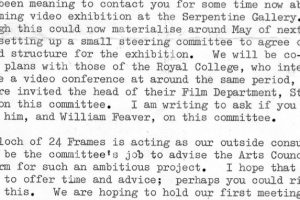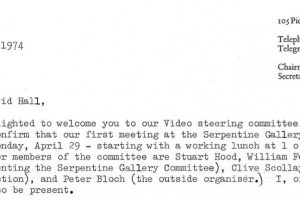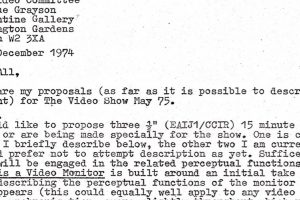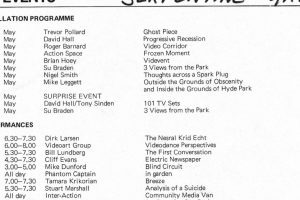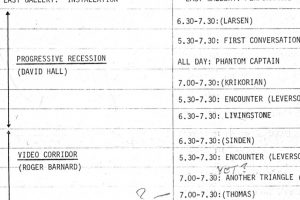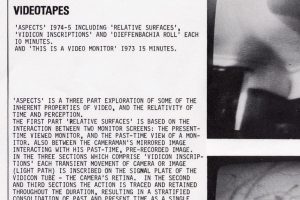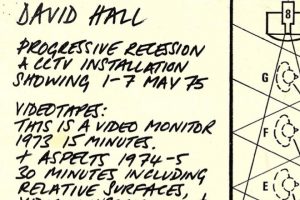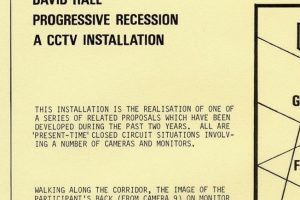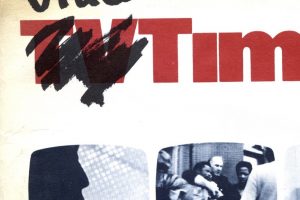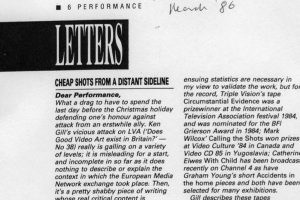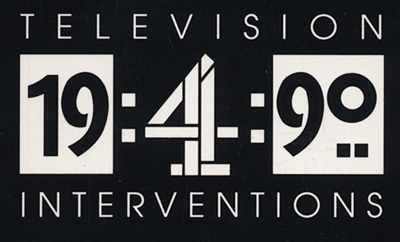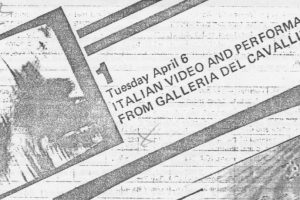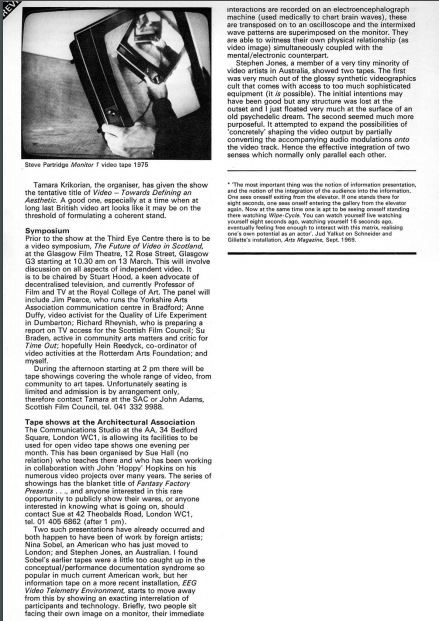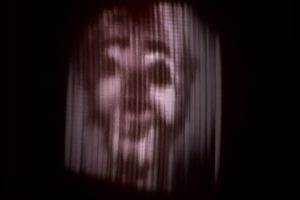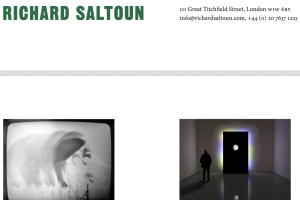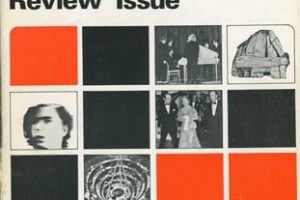Hall, David
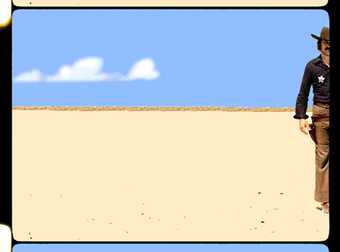
“David Hall’s contribution to British video art is unparalleled.. and his early experiments with broadcast television are unique. Not only are many of his video pieces classics.. but he has made important and often brilliant contributions to experimental film, installation and sculpture.. A founding member of the video art movement here in the early 1970s he was an influential activist on behalf of the infant art form..” M O’Pray, A Directory of British Film & Video Artists, 1996.
David Hall (1937-2016) studied architecture, Art and Design at Leicester College of Art (1954-60) and sculpture at the Royal College of Art (1960-1964). He was awarded first prize for sculpture at the Biennale de Paris (1965) and took part in the first major exhibition of Minimalist art, Primary Structures, New York (1966) before turning to photography, film and video. His first television interventions appeared on Scottish TV in 1971 and his first video installation was shown in London in 1972. His film and video single screen and installation work has been widely screened and exhibited in the UK and internationally at many venues including Documenta Kassel, Tate Gallery London, Centre Georges Pompidou Paris, National Museum Reina Sofia Madrid and the Museum of Modern Art Vienna.
He participated in the formation of the Artist Placement Group with John Latham and others in 1966; was co-organiser of the seminal international Video Show exhibition at the Serpentine Gallery, London in 1975; and was co-curator of the first video installations exhibition at the Tate Gallery, London in 1976. In the same year he initiated and was a founding member of the artists’ organisation London Video Arts (now part of LUX).
Appointed Honorary Professor at Dundee University in 2003 he has taught at the Royal College of Art, St Martin’s School of Art, Chelsea College of Art, San Francisco Art Institute, Nova Scotia College of Art and many others. He introduced the term ‘time-based media’ through his writings in Studio International and elsewhere, and created the first time-based art degree option with an emphasis on video at Maidstone College of Art, Kent (now University College of the Creative Arts) in 1972. He has made work for broadcast by, among others, BBC TV, Channel 4 TV, Scottish TV, Canal+ TV and MTV.
Sculpture, films, videotapes and/or related material at the Tate Gallery London, Museum of Modern Art New York, Museo National Reina Sofia Madrid, Gemeente Museum The Hague, West Australia Art Gallery Perth, Venice Biennale Archive, Calouste Gulbenkian Foundation, British Council, Arts Council of England, Contemporary Arts Society, British Film Institute, Great South West Corporation Atlanta USA, Richard Feigen Gallery New York, Visual Resources Inc. New York, Royal College of Art, Harvard University, ZKM Karlsruhe, Leicestershire Education Committee, and other public and private collections in Europe and the USA. Films and videotapes held by Lux London, British Film Institute, National Film and Television Archive, REWIND archive and Venice Biennale Archive .
David Hall is represented by Richard Saltoun Gallery https://www.richardsaltoun.com/artists/191-david-hall/
updated April 2022
-
Interview of David Hall
View the interview transcript here
-
Exhibitions:
1962
Towards Art, Royal College of Art Galleries, London.1963
Critic’s Choice: One Year of British Art 1962, Tooth Gallery, London (selector Edward Lucie-Smith).1964
Kasmin Prize, Young Contemporaries, London.
Four Young Artists, Institute of Contemporary Arts, London.1965
1st prize (Prix des Jeunes Artistes), and group prize (Prix de la Ville de Paris), IV Biennale de Paris, Musee d’Art Moderne, Paris.
Towards Art II, Arts Council Gallery and tour.1966
Primary Structures: Younger American and British Sculptors, Jewish Museum, New York.
Solo exhibition, Richard Feigen Gallery, New York.
Sonsbeek ’66, international sculpture exhibition, Arnheim.
Sculpture in the Open Air, Battersea Park, London.
White on White, Kunsthalle, Bern.
Contemporary Sculpture, Arts Council tour.1967
Solo prize-winner’s exhibition, V Biennale de Paris, Musee d’Art Moderne, Paris.
8 Young British Sculptors, Kunsthalles Bern, Dusseldorf and Stedelijk Museum, Amsterdam.
(Photo-pieces, films and video works from 1967 on).1968
Solo exhibition, Royal Institute Galleries, London.
Younger Generation – Great Britain, Akademie der Kunst, Berlin.
Contemporary British Sculpture, Coventry Cathedral.
City of London Festival.
(First film completed – Motion Parallax, 16mm, twin screen).1969
Plans and Projects as Art, Kunsthalles Bern, Munich and Hamburg.
(First artists experimental film funded by the Arts Council of Great Britain – Vertical, 16mm).1970
Displacement (Removal Piece), sanded floor in British Sculpture Out of the Sixties, Institute of Contemporary Arts, London.
Contemporary British Art, National Museum of Modern Art, Tokyo.
Drawings and Projects by 16 British Artists, C.A.Y.C, Buenos Aires.1971
TV Interruptions, ten works commissioned by the Scottish Arts Council and broadcast by Scottish Television, unannounced and uncredited (seven later preserved as 7 TV Pieces).
Inno 70, Artist Placement Group exhibition, Hayward Gallery, London.
Prospect 71: Projection, Kunsthalle, Dusseldorf.1972
60 TV Sets, multi-channel live broadcast television installation/ performance with Tony Sinden, at A Survey of the Avant-Garde in Britain, Gallery House, London.
Solo film show, Institute of Contemporary Arts, London.1973
Solo film show, National Film Theatre, London.
Video installation/performance in Open Circuit, Scottish Arts Council Gallery, Edinburgh.1974
Solo film show, Tate Gallery, London.
Solo film show, Millennium Cinema, New York.
Videotapes and films in the 5th Experimental Film Festival, Knokke-Heist, Belgium.1975
Co-organiser of the Arts Council’s The Video Show (first major international video exhibition in Britain); showed installations Progressive Recession (1974), 101 TV Sets, and videotapes, Serpentine Gallery, London.
First Festival of Independent British Cinema, Arnolfini Gallery, Bristol.1976
This is a Television Receiver, videotape featuring newsreader Richard Baker, commissioned and broadcast on BBC Television’s Arena video art special, presented by David Hall.
Vidicon Inscriptions, installation in the Video Show, Tate Gallery, London.
Installation and tapes in Video: Towards Defining an Aesthetic, Third Eye Centre, Glasgow.
International video exhibition, Amerika Haus, Berlin.
International video exhibition, International Cultural Centre, Antwerp.1977
Videotapes in Documenta 6, Kassel, Germany.
Perspectives on British Avant-Garde Film, Hayward Gallery, London.
Film en Video Manifestatie, Bonnefantenmuseum, Maastricht.
British Film and Video, Cavallino Gallery, Venice.
British Film and Video, Bon a Tirer Gallery, Milan.1978
The Situation Envisaged installation, plus videotapes, in Video Art 78, Herbert Art Gallery and Museum, Coventry.
Perspectives on British Avant-Garde Film, British Council tour of Britain, Australia and Europe including the Pompidou Centre, Paris.
London Video Arts opening exhibition, AIR Gallery, London.1979
Video: The First Decade, Museum of Folklore, Rome.
Videotapes by British Artists, the Kitchen, New York.
Personal tour, exhibitions and screenings in Canada.1980
A Situation Envisaged: The Rite, installation (solo exhibition), South Hill Park Arts, Bracknell.
Solo videotape show and lectures, Photographers’ Union, Warsaw.
Solo videotape retrospective, Institute of Contemporary Arts, London.1983
Video Art: A History, documentation show, Museum of Modern Art, New York.
Personal tour, exhibitions and screenings in the USA.
Installations, AIR Gallery, London.1984
Channel 5 exhibition, Institute of Contemporary Arts, London.1985
Videotapes screened by Channel 4 TV.1986
Channel 6 exhibition, Institute of Contemporary Arts, London.1987
The Elusive Sign, British Avant-Garde Film and Video (1977-1987), Tate Gallery London and Arts Council/British Council international tour.
Videotapes broadcast, WGBH/Channel 2, Boston, USA.
Videotapes broadcast, Finnish Television.1988
Total Dissent, films at the Tate Gallery, London.1989
A Situation Envisaged: The Rite II (Cultural Eclipse), installation commissioned for Video Positive 89, Tate Gallery, Liverpool.
Revision, videotapes at the Tate Gallery, London.
Videoculture2, videotapes at the Institut Francais de Naples1990
Stooky Bill TV, videotape commission for 19:4:90 Television Interventions, broadcast by Channel 4 TV followed by exhibitions at the Third Eye Centre, Glasgow and Ikon, Birmingham.
Four TV Interruptions (1971) broadcast by Channel 4 TV.
A Situation Envisaged: The Rite II (Cultural Eclipse), installation in Signs of the Times: A Decade of Video, Film and Slide-tape Installations, Museum of Modern Art, Oxford.1991
Solo video retrospective, Video Art Plastique festival, Herouville-Saint Clair, Caen, France.1992
TV Interruptions (1971) purchased and broadcast by Canal+ TV, France.
Solo videotape retrospective, ELAC, Lyon, France.
Solo film and videotape retrospective, New Visions Festival, Glasgow Film Theatre.1993
Signes des Temps, installations, Centre d’Art Contemporain, La Ferme du Buisson, Paris.
Five TV Interruptions 1993: reacTV, contexTV, exiTV, withouTV, and ecstaseeTV commissioned and broadcast internationally by MTV Networks.1997
Diverse Practices, screenings of videotapes, Institute of Contemporary Arts, London.
Films and videotapes in 60;70;80;90, Showroom Gallery, London.
Retrospective of single-screen films, videotapes and TV works, Lux Centre, London.
Videotapes cablecast from Utrecht.1998
Panelist and personal presentation of work in Dialogues with the Machine symposium, Institute of Contemporary Arts, London.1999
Video/TV works in Against the Mainstream: Artists’ films from the ’20s to the ’90s, National Film Theatre, London.2000
Live in Your Head: Concept and Experiment in Britain, 1965-75, Whitechapel Art Gallery, London.
Videotapes at Centre Georges Pompidou, Paris.
Videotapes in Canada/UK Video Exchange, Montreal, Vancouver, Winnipeg, Ontario and Buffalo, USA.2001
Live in Your Head: Concept and Experiment in Britain, 1965-75, Chiado Museum, Lisbon.2002
Shoot Shoot Shoot, Tate Modern Gallery, London and international tour.2003
Early British Video Works, Tate Britain Gallery, London.
A Century of Artists’ Film in Britain, Tate Britain Gallery, London.
Solo presentation of videotapes and films, Tate Britain Gallery, London.
Nothing Special: Artists Video, Media and Reality, FACT, Liverpool.2004
United Professors: David Hall, Wojciech Bruszewski, Wolf Kahlen, Ladislav Galeta, film and video presentations, Academy of Economics and Humanities, Lodz, and Nicolas Copernicus University, Torun, Poland.2005
Video Art: From the Margins to the Mainstream, symposium, Tate Britain, London.
Variety, De La Warr Pavilion, Bexhill2006
The Discovery of the Electronic Body – Art and video in the 1970s, Galleria Civica d’Arte Contemporanea, Turin.
Exploding Television, 35th International Film Festival, Rotterdam.
REWIND| Artists’ Video in the 70s & 80s, Visual Research Centre, Dundee Contemporary Arts
Test Transmissions: Video Art and Television, Centre for Contemporary Arts, Glasgow
First Generation: Art and the Moving Image 1963-1986, Museo Nacional Centro de Arte Reina Sofia, Madrid 2006-20072007
Solo presentation of video and film works, Lodz Arts Center, Lodz, Poland.
Video installation in RE: [Video Positive], FACT Gallery, Liverpool.
Video and film works in A History of Artists’ Film and Video in Britain, BFI Southbank, London.2009
We Interrupt This Program, Mercer Union Centre for Contemporary Art, Toronto.
Running Time – Artists Films in Scotland, Dean Gallery of Modern Art, Edinburgh.
Disconnect Festival, Venice.
Interruptions on BBC Big Screen, Edinburgh Festival.
Grey Matter, Talbot Rice Gallery, Edinburgh.
Rewind Artists’ Video in the 70s & 80s, Stills Gallery, Edinburgh.2010
Video installation in Changing Channels: Art and Television 1963-1987, MUMOK Museum of Modern Art, Vienna. -
Videography:
1971
TV Interruptions (7 TV Pieces):
Interruption piece
Window piece
Tap piece
Time-lapse piece
Pans piece
TV shoot-out piece
Two figures piece1972
60 TV Sets, multi-TV installation1973
This is a Video Monitor1973-74 Vidicon Inscriptions, videotape
1974
Relative Surfaces
Progressive Recession, interactive video installation1975
101 TV Sets, multi-TV installation
Vidicon Inscriptions, interactive video installation1976
Waterwork – Narcissus I, interactive video installation
Waterwork – Narcissus II, interactive video installation
This is a Television Receiver1977
Interplay
TV Fighter (Cam Era Plane)1978
Ghost Story
The Situation Envisaged, multi-screen video installation1979
The Situation Envisaged II, multi-screen video installation1980
A Situation Envisaged: The Rite, multi-screen video installation
A Situation Envisaged: The Rite II (Cultural Eclipse), multi-screen video installation1990
Stooky Bill TV1993
TV Interruptions 93:
reacTV
contexTV
withouTV
exiTV
ecstaseeTV -
Artist works:
-
Artist organisations:
-
Artist assets:
-
Quotes:
David Hall has often been cited as the most influential pioneer of video art in Britain. His exploration of the form and illusion of the medium; his awareness of material conditions; and the cultural resonance of the context of artists' & video within broadcast television has a consistency of expression and purpose unmatched by peers or later artists.
Such citations, however, constrain and marginalise his output by overlooking the breadth of his work over thirty years as an artist. Trained as an architect and then sculptor, the path through sculpture, film, video and television work traces and reveals the dexterity, intelligence, dry wit and passion of a singular artist.'
- Allan Woods, Editor, introducing an interview by Stephen Partridge with the artist, Transcript magazine, vol 3, issue 3, 1999.'A single figure dominates the beginnings of video art in Britain - David Hall.... His early experiments with broadcast television are unique...' - Michael O'Pray, British Film Institute Monthly Film Bulletin, February 1988.
'For [Hall].. the video medium was an unexplored territory for artists, its codes yet uncracked. He argued that video art was integral to television and not just its technical by-product. TV - and its subversion - was where video's vital core was located, well beyond the ghettos of film co-ops, arts labs and art galleries. This view opened an unusual space, somewhere between high art formalism (which it resembled) and the mass arts (which it didn't). Anti-aesthetic and anti-populist - conceptual art with a looser, Dada streak...' - Al Rees, Monitoring Partridge Catalogue, University of Dundee 1999
'Traditional artforms can no longer compete with the Media. Today the Media is all-powerful. It cautiously embraces art and quickly discards it in this throwaway culture. The Media has taken the place of art. It sees itself as culturally independent, yet totally depends on the culture that surrounds it. This is its sustenance, and traditional artforms are devoured along with other cultural activity. Of all the Media television is undoubtedly the key mediator, even the climatic controller, of present-day culture. That I should adopt TV as my artform - as the vehicle for an alternative mediation or critique of that culture, and by implication of TV itself - was highly appropriate...' - David Hall, Video Art Plastique exhibition cat., Herouville-Saint Clair, France 1991.
'When I made sculpture in the sixties I photographed it, but two dimensional pictures said little about my work. However, if people didn't see the sculpture they more or less believed they had if they saw the photographs. They made judgements about it, they were used to that from looking at images. I decided they were probably more important than the sculpture and turned to making only photographs.
I then recognised the illusion was even more convincing when it moved and had sound, so I started to make films. But I wasn't always interested in making the illusion convincing, if it was it would be like looking at something else, not at a film. I used illusion only as a means to see itself. If I had denied using it altogether it would be very convenient and & true to the mechanics and process of film, but illusion would still be there because people wanted it to be. They expected that from looking at films. I became very interested in their expectations, but did not necessarily want to give them what they might expect.
...I soon became interested in television. TV as a medium (and its offspring video) was a different proposition. Viewing TV was not a special event with a captive audience like film, but it reached everyone... and with TV people mostly got what they expected...[and] my interests in film transposed to TV. But the context was very different and the work had to respond to that. TV art was something else...' - David Hall, Structures, Paraphenalia and Television, Sign of the Times Cat., Museum of Modern Art, Oxford, 1990.“ In 1971 David Hall made ten ‘TV Interruptions’ for Scottish TV which were broadcast, unannounced, in August and September of that year (a selection of seven of the ten was later issued as ‘7 TV Pieces’). These, his first works for television, are examples of what Television Interventions, as they came to be known, can be. Although a number of interventions have subsequently been made by various artists, the ‘7 TV Pieces’ have not been surpassed, except by Hall himself in ‘This is a Television Receiver’ (1976) and ‘Stooky Bill TV’ (1990)...”
Nicky Hamlyn, Film Video and TV, Coil magazine 9/10, London 2000."...Although each Piece has its own specific quality and repays repeated viewing in varying degrees, Hall has insisted [that] 'the pieces were not intended as declarations of art in their own right, they did not assume that privilege. They were gestures and foils within the context of..TV. They needed TV, they depended on it.' Hall is critical of specialist arts programmes [art galleries on air] which 'call the few and exclude the many', and in a letter to Studio International [March 1972] Alistair MacIntosh, curator of the Edinburgh event, echoed Hall's strictures. He pointed out that the Pieces reached 'an audience of 250,000 per night. They didn't know what they were looking at and didn't expect it, so all the rubbish surrounding art was circumvented.' "
Mick Hartney on TV Interruptions 1971 in the book Diverse Practices: A Critical Reader on British Video Art (Arts Council of England/ John Libbey) 1996.“ ... The idea of inserting them as interruptions to regular programmes was crucial and a major influence on their content. That they appeared unannounced with no titles (two or three times a day over ten days) was essential. To get a TV company to agree to show them, and with these conditions, was a coup...
“ The transmissions were a surprise, a mystery. No explanations, no excuses. Reactions were various. I viewed one piece in an old gents’ club. The TV was permanently on but the occupants were oblivious to it, reading newspapers or dozing. When the TV began to fill with water newspapers dropped, the dozing stopped. When the piece finished normal activity was resumed. When announcing to shop assistants and engineers in a local TV shop that another was
about to appear they welcomed me in. When it finished I was obliged to leave quickly by the back door. I took these as positive reactions...”
David Hall in “19.4.90 - Television Interventions” catalogue, 1990.“ ‘Tap’ is probably the most well-known of the ‘7 TV Pieces’. Unseen hands place a tap inside a glass tank, framed so that the tank’s edges coincide with the sides of the TV. The tap is turned on, filling the space with water until it itself is submerged. The tank continues to fill until the meniscus - the surface line of the water - rises out of view. The tap is withdrawn and turned off, leaving that most forbidden of things, a blank silent screen. After a pause of several seconds the plug is pulled and the tank empties, now with the meniscus cutting acoss the screen at a 45 degree angle. Beyond the reference to the box as as glass-fronted container, the piece serves to demonstrate how framing is crucial in determining how we understand an image, and hence how meaning is created, not just by what framing includes, but also in the sense of the editorial function is performs. This leads to a wider reading of the work as a critique of the largely invisible editorial practices of programme makers and indeed the TV institutions...”
Nicky Hamlyn in Coil magazine 9/10, London 2000“ ...the Pieces [were not] calculated simply to alert or confuse the TV audience. In one [‘Two Figures’] the respective stillness and frenetic movement of the figures in a room depended for its perceptual effect on a complex interpretative process on the part of the viewer whereby the ‘reading’ of the technical manipulation of the scene - i.e. the unnatural acceleration of the moving figure - is ‘subverted’ by the prolonged stationary presence of the seated figure. In this Piece - in my opinion the strongest - by juxtaposing within a single scene a figure whose behaviour is largely cinematically-generated with one whose appearance suggests the medium is transparent, Hall brought vividly to the fore the inherent contradictions of that medium.”
Mick Hartney in Diverse Practices: A Critical Reader on British Video Art,1996.“ Traditional artforms can no longer compete with the Media. Today the Media is all-powerful. It cautiously embraces art and quickly discards it in this throwaway culture. The Media has taken the place of art. It sees itself as culturally independent, yet totally depends on the culture that surrounds it. This is its sustenance, and traditional artforms are devoured along with other cultural activity. Of all the Media television is undoubtedly the key mediator, even the climatic controller, of present-day culture. That I should adopt TV as my artform - as the vehicle for an alternative mediation or critique of that culture, and by implication of TV itself - was highly appropriate...”
David Hall, Video Art Plastique exhibition cat., Herouville-Saint Clair, France 1991.“ The pieces were not intended as declarations of art in their own right, they did not assume that privilege. They were gestures and foils within the predictable form and endless inconsequentiality of TV. They needed TV, they depended on it...”
David Hall on TV INTERRUPTIONS 1971, 19:4:90 Television Interventions cat., Channel 4 TV and Fields and Frames, Scotland, 1990.



